
Search form
Plagiarism in academic writing: how to identify and avoid it.
BY SCOTT RAGIN
In the academic world, plagiarism is considered as a serious offense because stealing the work of another writer is an unacceptable tactic. Today, falling into the plagiarism trap became very easy and even tempting because the Internet has all information that could possibly be needed for a research paper, essay, article, or review. Unfortunately, many students and even some scholars make this mistake every year because a lack of their effort to write original text is easily detected by sophisticated software packages at education institutions.
The punishment for plagiarism offense is quite serious and often results in destroyed academic reputation, zero grade, and even expulsion from the educational institution. These short- and long-term consequences can be a bad influence on your academic career, so considering plagiarism as an option to complete an assignment should really be out of question. Instead of using this option, try some of these great and proven strategies to identify unoriginal content and avoid it in the future.
Strategy 1: Use Anti-plagiarism software
Identifying plagiarism is easy these days. There are a lot of websites that have sophisticated software that detects it in the matter of minutes. This online software is very easy to use: just copy the text you need to check and click “check” button. When the check is completed, you will be provided with a plagiarism report with the percent of the original text and the plagiarized areas will be highlighted for you to change.
Strategy 2: Paraphrasing
This strategy falls into “avoiding” category. Imagine this: you have found the information that is perfect for using in your paper. Instead of copying it, read it to the end to really understand the essence of the text. Now, when you know what the content is about, you can put it into your own words, which will help to avoid having unoriginal text. It is generally advised not to copy more than three or four words from the text without having them paraphrased.
Strategy 3: Quoting
This means that you take a short chunk of text from the source (usually a part of the sentence that has some important information for your topic) and leave it without changes. In many cases, when you need to provide the original definition of the writer or state his or her point of view, it is allowed to have their words quoted. Just put the quotation marks at the beginning and at the end of the quote; for example:
Competitive advantage is defined as “the source of company’s competitiveness” (Johnson, 2016, p. 123).
However, you need to remember that most of the text needs to be paraphrased, so the use of quotes should be significantly limited. Also, citation styles have specific formatting requirements for quotes, so be sure to follow them as well.
Strategy 4: Citing
It is one of the most widely used strategies in the academic world. It is the way of referring to the works of other authors with the use of parenthetical citation. Essentially, citing is conveying the thoughts of others via your own words and giving the credit to them. In addition to academic papers, this method is used in business reports, government agencies’ publications, and other works. Here is the example of APA style citation:
The effectiveness of student motivation is measured by their academic performance (Johnson, 2016).
As you can see in this example, you need to follow the rules of formatting styles as well. Contact your instructor to know which citation style is used by your institution.
Strategy 5: Get help of professionals
If you are short on time to deliver an academic work due to personal or other reasons, consider using the help of professional writing services. They hire writers with relevant academic background in particular areas to deliver the best work for the customers and, more importantly, provide original texts with plagiarism reports to prove that the text was not plagiarized. Of course, it is better to develop your academic writing skills by yourself but there is no shame in using the services of professionals when you are short on time.
The Bottom Line
Plagiarism is unprofessional, illegal, and disregarding, so avoiding it at all cost is the best possible strategy for modern students. Professors often say that it is better to miss the deadline rather than submit a plagiarized assignment and they are totally right about that. Fortunately, there are a number of strategies you can utilize to avoid plagiarizing the text that is widely recognized in the academic community.
Use these strategies to make sure your academic career advances with every written assignment you make. Besides, following academic integrity rules will also contribute to your professional career because you will develop appropriate work ethics that appreciates originality and quality of work.
Scott Ragin is a qualified educator, author and scholar. He is experienced in classroom teaching, training teachers and leaders and advising academic researchers. Scott provides assignment help at Aussiewriter and covers different topics concerning higher education and educational technology. Feel free to contact him at Facebook .
Leave a comment
Your email address will not be published. Required fields are marked *
Save my name, email, and website in this browser for the next time I comment.
- Stanford Home
- Maps & Directions
- Search Stanford
- Emergency Info
- Terms of Use
- Non-Discrimination
- Accessibility
© Stanford University , Stanford , California 94305 .
- Our Mission
Why Students Plagiarize
One teacher addresses plagiarism by examining the underlying causes such as a lack of confidence or time management skills.

It’s happening again. I feel the sentence structure at a subdermal level and know I’m confronting plagiarism before my eyes reach the period. A quick Google search reveals that my ninth-grade student did not write this sentence: “The memories stirred by the song cause Odysseus to weep, and, though he tries to hide it, the king notices and distracts the crowd by suggesting they begin an athletic competition.”
No single word in the passage is beyond my student’s reach, but I know what his writing sounds like—and this is not it. My search leads me to a site called Course Hero where “his” words appear. I email the student with a link to the site and ask him to come in to discuss. He responds politely, but he is adamant that he has never been on the site. “You can check my computer history,” he says. I schedule a meeting with him.
In 20 years of teaching, I’ve found ways to decrease plagiarism, but I have yet to eliminate it. Plagiarism frustrates me not only because it is cheating but also because it makes me feel as though my teaching has fallen short.
The Council of Writing Program Administrators identifies causes of plagiarism , including students’ fear of taking risks in their writing, having poor time management skills, and viewing the assignment and standards for documentation as unimportant.
Addressing plagiarism requires building students’ confidence in their writing, developing skills to navigate school stress, fostering investment in the assignment, and creating understanding of plagiarism and attribution. As a teacher, I have agency to address these issues. My response to plagiarism addresses four forces that lead a student to plagiarize.
Satisfaction With One’s Own Words
Students are sometimes maddened by the lumpy, inelegant sound of their writing. They read the words of someone with years of experience that sound so much more fluid. They might experiment with switching out a few synonyms or just paste the passage into their document. “That’s what I was going to say anyway,” a student once said in defense of a copied passage.
I tell my students that they have to write like a ninth grader before they can write like a tenth grader. The trick is to keep writing, in their own voice and with their own words. There are no shortcuts.
If I praise my students and use gentle methods to nudge them along, I hope they will trust themselves as writers. If my response sows doubt, they may lose faith in their own voices and look for someone else’s words.
The Value of the Assignment
The task of stringing one’s thoughts together can be daunting—especially if students aren’t invested in their thoughts initially. The Council of Writing Program Administrators argues that when presented with “generic or unparticularized” assignments, “students may believe they are justified in looking for canned responses.”
In the earlier example, the student hadn’t plagiarized the “thinking” part of the writing; he’d plagiarized the “generic” summary portion.
I want to introduce students to Homer’s epics, and I want them to understand the value of summary when writing about literature. I want them to analyze patterns and themes in their reading. Was this assignment the best way to teach these skills? Upon reflection, offering a mini-lesson on summary would have turned the rote part of this assignment into an opportunity for refining a valuable skill. Recognizing my unintended complicity is important in decreasing students’ motivation for cheating.
In their book Beyond Literary Analysis , Allison Marchetti and Rebekah O’Dell assert that students’ analyses are more vibrant and authentic when the students are driven by the passion and authority that come from writing about their own areas of expertise.
Revealing Roadblocks
The student who plagiarized had missed class and submitted the paper late. I explained that the passage he had used could be found in various places and that I was not concerned with where he found it, but rather why he used it instead of his own words.
In discussing the why, we focused on the roadblocks the student perceived. I gave him a mini-lesson on summarizing, and he practiced it right on the spot. We discussed attribution, and brainstormed attributive tags. We talked about ways to address the pressure of facing past-due assignments, and when he suggested “ask for help” I cheered his answer. He offered to rewrite the summary.
Understanding Plagiarism
There are times students may not understand how writers use others’ ideas and words. Understanding attribution and citation is an important skill for avoiding plagiarism. A colleague asked students to draw a map for the setting in To Kill a Mockingbird . A student painstakingly redrew one she found on Google, not understanding that she was to devise the map from textual evidence in the book.
Particularly in this age of rapid-fire reposting and image sharing, our students’ perception of copying might not match ours. In “ Of Flattery and Thievery: Reconsidering Plagiarism in a Time of Virtual Information ,” education professor P.L. Thomas writes that helping students understand plagiarism requires outlining a framework for defining terms, developing guidelines, and establishing consequences.
No two plagiarism episodes are alike, but all offer learning opportunities for both the student and the teacher. In the Odysseus example, I decided to give the student half credit for his paper. I explained that aside from the plagiarized first paragraph, his analysis exhibited solid thinking and expression. In short, I valued his work. I reminded him of repercussions of future plagiarism, which in our school involves disciplinary action. This was one of the final papers of the semester, but I will check in with him next fall, revisit the struggles he mentioned, and remind him that I am his ally on his road to becoming a competent writer.
- Utility Menu
fa3d988da6f218669ec27d6b6019a0cd
A publication of the harvard college writing program.
Harvard Guide to Using Sources
- The Honor Code
- What Constitutes Plagiarism?
In academic writing, it is considered plagiarism to draw any idea or any language from someone else without adequately crediting that source in your paper. It doesn't matter whether the source is a published author, another student, a website without clear authorship, a website that sells academic papers, or any other person: Taking credit for anyone else's work is stealing, and it is unacceptable in all academic situations, whether you do it intentionally or by accident.
The ease with which you can find information of all kinds online means that you need to be extra vigilant about keeping track of where you are getting information and ideas and about giving proper credit to the authors of the sources you use. If you cut and paste from an electronic document into your notes and forget to clearly label the document in your notes, or if you draw information from a series of websites without taking careful notes, you may end up taking credit for ideas that aren't yours, whether you mean to or not.
It's important to remember that every website is a document with an author, and therefore every website must be cited properly in your paper. For example, while it may seem obvious to you that an idea drawn from Professor Steven Pinker's book The Language Instinct should only appear in your paper if you include a clear citation, it might be less clear that information you glean about language acquisition from the Stanford Encyclopedia of Philosophy website warrants a similar citation. Even though the authorship of this encyclopedia entry is less obvious than it might be if it were a print article (you need to scroll down the page to see the author's name, and if you don't do so you might mistakenly think an author isn't listed), you are still responsible for citing this material correctly. Similarly, if you consult a website that has no clear authorship, you are still responsible for citing the website as a source for your paper. The kind of source you use, or the absence of an author linked to that source, does not change the fact that you always need to cite your sources (see Evaluating Web Sources ).
Verbatim Plagiarism
If you copy language word for word from another source and use that language in your paper, you are plagiarizing verbatim . Even if you write down your own ideas in your own words and place them around text that you've drawn directly from a source, you must give credit to the author of the source material, either by placing the source material in quotation marks and providing a clear citation, or by paraphrasing the source material and providing a clear citation.
The passage below comes from Ellora Derenoncourt’s article, “Can You Move to Opportunity? Evidence from the Great Migration.”
Here is the article citation in APA style:
Derenoncourt, E. (2022). Can you move to opportunity? Evidence from the Great Migration. The American Economic Review , 112(2), 369–408. https://doi.org/10.1257/aer.20200002
Source material
Why did urban Black populations in the North increase so dramatically between 1940 and 1970? After a period of reduced mobility during the Great Depression, Black out-migration from the South resumed at an accelerated pace after 1940. Wartime jobs in the defense industry and in naval shipyards led to substantial Black migration to California and other Pacific states for the first time since the Migration began. Migration continued apace to midwestern cities in the 1950s and1960s, as the booming automobile industry attracted millions more Black southerners to the North, particularly to cities like Detroit or Cleveland. Of the six million Black migrants who left the South during the Great Migration, four million of them migrated between 1940 and 1970 alone.
Plagiarized version
While this student has written her own sentence introducing the topic, she has copied the italicized sentences directly from the source material. She has left out two sentences from Derenoncourt’s paragraph, but has reproduced the rest verbatim:
But things changed mid-century. After a period of reduced mobility during the Great Depression, Black out-migration from the South resumed at an accelerated pace after 1940. Wartime jobs in the defense industry and in naval shipyards led to substantial Black migration to California and other Pacific states for the first time since the Migration began. Migration continued apace to midwestern cities in the 1950s and1960s, as the booming automobile industry attracted millions more Black southerners to the North, particularly to cities like Detroit or Cleveland.
Acceptable version #1: Paraphrase with citation
In this version the student has paraphrased Derenoncourt’s passage, making it clear that these ideas come from a source by introducing the section with a clear signal phrase ("as Derenoncourt explains…") and citing the publication date, as APA style requires.
But things changed mid-century. In fact, as Derenoncourt (2022) explains, the wartime increase in jobs in both defense and naval shipyards marked the first time during the Great Migration that Black southerners went to California and other west coast states. After the war, the increase in jobs in the car industry led to Black southerners choosing cities in the midwest, including Detroit and Cleveland.
Acceptable version #2 : Direct quotation with citation or direct quotation and paraphrase with citation
If you quote directly from an author and cite the quoted material, you are giving credit to the author. But you should keep in mind that quoting long passages of text is only the best option if the particular language used by the author is important to your paper. Social scientists and STEM scholars rarely quote in their writing, paraphrasing their sources instead. If you are writing in the humanities, you should make sure that you only quote directly when you think it is important for your readers to see the original language.
In the example below, the student quotes part of the passage and paraphrases the rest.
But things changed mid-century. In fact, as Derenoncourt (2022) explains, “after a period of reduced mobility during the Great Depression, Black out-migration from the South resumed at an accelerated pace after 1940” (p. 379). Derenoncourt notes that after the war, the increase in jobs in the car industry led to Black southerners choosing cities in the midwest, including Detroit and Cleveland.
Mosaic Plagiarism
If you copy bits and pieces from a source (or several sources), changing a few words here and there without either adequately paraphrasing or quoting directly, the result is mosaic plagiarism . Even if you don't intend to copy the source, you may end up with this type of plagiarism as a result of careless note-taking and confusion over where your source's ideas end and your own ideas begin. You may think that you've paraphrased sufficiently or quoted relevant passages, but if you haven't taken careful notes along the way, or if you've cut and pasted from your sources, you can lose track of the boundaries between your own ideas and those of your sources. It's not enough to have good intentions and to cite some of the material you use. You are responsible for making clear distinctions between your ideas and the ideas of the scholars who have informed your work. If you keep track of the ideas that come from your sources and have a clear understanding of how your own ideas differ from those ideas, and you follow the correct citation style, you will avoid mosaic plagiarism.
Indeed, of the more than 3500 hours of instruction during medical school, an average of less than 60 hours are devoted to all of bioethics, health law and health economics combined . Most of the instruction is during the preclinical courses, leaving very little instructional time when students are experiencing bioethical or legal challenges during their hands-on, clinical training. More than 60 percent of the instructors in bioethics, health law, and health economics have not published since 1990 on the topic they are teaching.
--Persad, G.C., Elder, L., Sedig,L., Flores, L., & Emanuel, E. (2008). The current state of medical school education in bioethics, health law, and health economics. Journal of Law, Medicine, and Ethics 36 , 89-94.
Students can absorb the educational messages in medical dramas when they view them for entertainment. In fact, even though they were not created specifically for education, these programs can be seen as an entertainment-education tool [43, 44]. In entertainment-education shows, viewers are exposed to educational content in entertainment contexts, using visual language that is easy to understand and triggers emotional engagement [45]. The enhanced emotional engagement and cognitive development [5] and moral imagination make students more sensitive to training [22].
--Cambra-Badii, I., Moyano, E., Ortega, I., Josep-E Baños, & Sentí, M. (2021). TV medical dramas: Health sciences students’ viewing habits and potential for teaching issues related to bioethics and professionalism. BMC Medical Education, 21 , 1-11. doi: https://doi.org/10.1186/s12909-021-02947-7
Paragraph #1.
All of the ideas in this paragraph after the first sentence are drawn directly from Persad. But because the student has placed the citation mid-paragraph, the final two sentences wrongly appear to be the student’s own idea:
In order to advocate for the use of medical television shows in the medical education system, it is also important to look at the current bioethical curriculum. In the more than 3500 hours of training that students undergo in medical school, only about 60 hours are focused on bioethics, health law, and health economics (Persad et al, 2008). It is also problematic that students receive this training before they actually have spent time treating patients in the clinical setting. Most of these hours are taught by instructors without current publications in the field.
Paragraph #2.
All of the italicized ideas in this paragraph are either paraphrased or taken verbatim from Cambra-Badii, et al., but the student does not cite the source at all. As a result, readers will assume that the student has come up with these ideas himself:
Students can absorb the educational messages in medical dramas when they view them for entertainment. It doesn’t matter if the shows were designed for medical students; they can still be a tool for education. In these hybrid entertainment-education shows, viewers are exposed to educational content that triggers an emotional reaction. By allowing for this emotional, cognitive, and moral engagement, the shows make students more sensitive to training . There may be further applications to this type of education: the role of entertainment as a way of encouraging students to consider ethical situations could be extended to other professions, including law or even education.
The student has come up with the final idea in the paragraph (that this type of ethical training could apply to other professions), but because nothing in the paragraph is cited, it reads as if it is part of a whole paragraph of his own ideas, rather than the point that he is building to after using the ideas from the article without crediting the authors.
Acceptable version
In the first paragraph, the student uses signal phrases in nearly every sentence to reference the authors (“According to Persad et al.,” “As the researchers argue,” “They also note”), which makes it clear throughout the paragraph that all of the paragraph’s information has been drawn from Persad et al. The student also uses a clear APA in-text citation to point the reader to the original article. In the second paragraph, the student paraphrases and cites the source’s ideas and creates a clear boundary behind those ideas and his own, which appear in the final paragraph.
In order to advocate for the use of medical television shows in the medical education system, it is also important to look at the current bioethical curriculum. According to Persad et al. (2008), only about one percent of teaching time throughout the four years of medical school is spent on ethics. As the researchers argue, this presents a problem because the students are being taught about ethical issues before they have a chance to experience those issues themselves. They also note that more than sixty percent of instructors teaching bioethics to medical students have no recent publications in the subject.
The research suggests that medical dramas may be a promising source for discussions of medical ethics. Cambra-Badii et al. (2021) explain that even when watched for entertainment, medical shows can help viewers engage emotionally with the characters and may prime them to be more receptive to training in medical ethics. There may be further applications to this type of education: the role of entertainment as a way of encouraging students to consider ethical situations could be extended to other professions, including law or even education.
Inadequate Paraphrase
When you paraphrase, your task is to distill the source's ideas in your own words. It's not enough to change a few words here and there and leave the rest; instead, you must completely restate the ideas in the passage in your own words. If your own language is too close to the original, then you are plagiarizing, even if you do provide a citation.
In order to make sure that you are using your own words, it's a good idea to put away the source material while you write your paraphrase of it. This way, you will force yourself to distill the point you think the author is making and articulate it in a new way. Once you have done this, you should look back at the original and make sure that you have represented the source’s ideas accurately and that you have not used the same words or sentence structure. If you do want to use some of the author's words for emphasis or clarity, you must put those words in quotation marks and provide a citation.
The passage below comes from Michael Sandel’s article, “The Case Against Perfection.” Here’s the article citation in MLA style:
Sandel, Michael. “The Case Against Perfection.” The Atlantic , April 2004, https://www.theatlantic.com/magazine/archive/2004/04/the-case-against-pe... .
Though there is much to be said for this argument, I do not think the main problem with enhancement and genetic engineering is that they undermine effort and erode human agency. The deeper danger is that they represent a kind of hyperagency—a Promethean aspiration to remake nature, including human nature, to serve our purposes and satisfy our desires. The problem is not the drift to mechanism but the drive to mastery. And what the drive to mastery misses and may even destroy is an appreciation of the gifted character of human powers and achievements.
The version below is an inadequate paraphrase because the student has only cut or replaced a few words: “I do not think the main problem” became “the main problem is not”; “deeper danger” became “bigger problem”; “aspiration” became “desire”; “the gifted character of human powers and achievements” became “the gifts that make our achievements possible.”
The main problem with enhancement and genetic engineering is not that they undermine effort and erode human agency. The bigger problem is that they represent a kind of hyperagency—a Promethean desire to remake nature, including human nature, to serve our purposes and satisfy our desires. The problem is not the drift to mechanism but the drive to mastery. And what the drive to mastery misses and may even destroy is an appreciation of the gifts that make our achievements possible (Sandel).
Acceptable version #1: Adequate paraphrase with citation
In this version, the student communicates Sandel’s ideas but does not borrow language from Sandel. Because the student uses Sandel’s name in the first sentence and has consulted an online version of the article without page numbers, there is no need for a parenthetical citation.
Michael Sandel disagrees with the argument that genetic engineering is a problem because it replaces the need for humans to work hard and make their own choices. Instead, he argues that we should be more concerned that the decision to use genetic enhancement is motivated by a desire to take control of nature and bend it to our will instead of appreciating its gifts.
Acceptable version #2: Direct quotation with citation
In this version, the student uses Sandel’s words in quotation marks and provides a clear MLA in-text citation. In cases where you are going to talk about the exact language that an author uses, it is acceptable to quote longer passages of text. If you are not going to discuss the exact language, you should paraphrase rather than quoting extensively.
The author argues that “the main problem with enhancement and genetic engineering is not that they undermine effort and erode human agency,” but, rather that “they represent a kind of hyperagency—a Promethean desire to remake nature, including human nature, to serve our purposes and satisfy our desires. The problem is not the drift to mechanism but the drive to mastery. And what the drive to mastery misses and may even destroy is an appreciation of the gifts that make our achievements possible” (Sandel).
Uncited Paraphrase
When you use your own language to describe someone else's idea, that idea still belongs to the author of the original material. Therefore, it's not enough to paraphrase the source material responsibly; you also need to cite the source, even if you have changed the wording significantly. As with quoting, when you paraphrase you are offering your reader a glimpse of someone else's work on your chosen topic, and you should also provide enough information for your reader to trace that work back to its original form. The rule of thumb here is simple: Whenever you use ideas that you did not think up yourself, you need to give credit to the source in which you found them, whether you quote directly from that material or provide a responsible paraphrase.
The passage below comes from C. Thi Nguyen’s article, “Echo Chambers and Epistemic Bubbles.”
Here’s the citation for the article, in APA style:
Nguyen, C. (2020). Echo chambers and epistemic bubbles. Episteme, 17 (2), 141-161. doi:10.1017/epi.2018.32
Epistemic bubbles can easily form accidentally. But the most plausible explanation for the particular features of echo chambers is something more malicious. Echo chambers are excellent tools to maintain, reinforce, and expand power through epistemic control. Thus, it is likely (though not necessary) that echo chambers are set up intentionally, or at least maintained, for this functionality (Nguyen, 2020).
The student who wrote the paraphrase below has drawn these ideas directly from Nguyen’s article but has not credited the author. Although she paraphrased adequately, she is still responsible for citing Nguyen as the source of this information.
Echo chambers and epistemic bubbles have different origins. While epistemic bubbles can be created organically, it’s more likely that echo chambers will be formed by those who wish to keep or even grow their control over the information that people hear and understand.
In this version, the student eliminates any possible ambiguity about the source of the ideas in the paragraph. By using a signal phrase to name the author whenever the source of the ideas could be unclear, the student clearly attributes these ideas to Nguyen.
According to Nguyen (2020), echo chambers and epistemic bubbles have different origins. Nguyen argues that while epistemic bubbles can be created organically, it’s more likely that echo chambers will be formed by those who wish to keep or even grow their control over the information that people hear and understand.
Uncited Quotation
When you put source material in quotation marks in your essay, you are telling your reader that you have drawn that material from somewhere else. But it's not enough to indicate that the material in quotation marks is not the product of your own thinking or experimentation: You must also credit the author of that material and provide a trail for your reader to follow back to the original document. This way, your reader will know who did the original work and will also be able to go back and consult that work if they are interested in learning more about the topic. Citations should always go directly after quotations.
The passage below comes from Deirdre Mask’s nonfiction book, The Address Book: What Street Addresses Reveal About Identity, Race, Wealth, and Power.
Here is the MLA citation for the book:
Mask, Deirdre. The Address Book: What Street Addresses Reveal About Identity, Race, Wealth, and Power. St. Martin’s Griffin, 2021.
In New York, even addresses are for sale. The city allows a developer, for the bargain price of $11,000 (as of 2019), to apply to change the street address to something more attractive.
It’s not enough for the student to indicate that these words come from a source; the source must be cited:
After all, “in New York, even addresses are for sale. The city allows a developer, for the bargain price of $11,000 (as of 2019), to apply to change the street address to something more attractive.”
Here, the student has cited the source of the quotation using an MLA in-text citation:
After all, “in New York, even addresses are for sale. The city allows a developer, for the bargain price of $11,000 (as of 2019), to apply to change the street address to something more attractive” (Mask 229).
Using Material from Another Student's Work
In some courses you will be allowed or encouraged to form study groups, to work together in class generating ideas, or to collaborate on your thinking in other ways. Even in those cases, it's imperative that you understand whether all of your writing must be done independently, or whether group authorship is permitted. Most often, even in courses that allow some collaborative discussion, the writing or calculations that you do must be your own. This doesn't mean that you shouldn't collect feedback on your writing from a classmate or a writing tutor; rather, it means that the argument you make (and the ideas you rely on to make it) should either be your own or you should give credit to the source of those ideas.
So what does this mean for the ideas that emerge from class discussion or peer review exercises? Unlike the ideas that your professor offers in lecture (you should always cite these), ideas that come up in the course of class discussion or peer review are collaborative, and often not just the product of one individual's thinking. If, however, you see a clear moment in discussion when a particular student comes up with an idea, you should cite that student. In any case, when your work is informed by class discussions, it's courteous and collegial to include a discursive footnote in your paper that lets your readers know about that discussion. So, for example, if you were writing a paper about the narrator in Tim O'Brien's The Things They Carried and you came up with your idea during a discussion in class, you might place a footnote in your paper that states the following: "I am indebted to the members of my Expos 20 section for sparking my thoughts about the role of the narrator as Greek Chorus in Tim O'Brien's The Things They Carried ."
It is important to note that collaboration policies can vary by course, even within the same department, and you are responsible for familiarizing yourself with each course's expectation about collaboration. Collaboration policies are often stated in the syllabus, but if you are not sure whether it is appropriate to collaborate on work for any course, you should always consult your instructor.
- The Exception: Common Knowledge
- Other Scenarios to Avoid
- Why Does it Matter if You Plagiarize?
- How to Avoid Plagiarism
- Harvard University Plagiarism Policy
PDFs for This Section
- Avoiding Plagiarism
- Online Library and Citation Tools
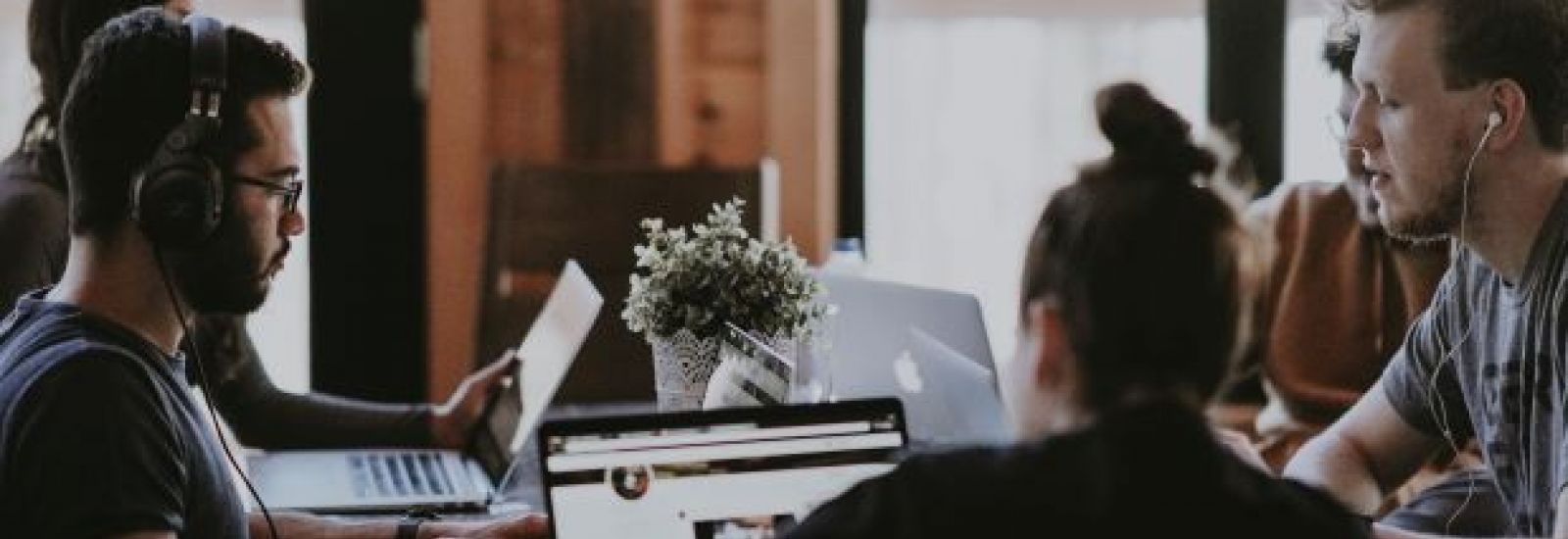
Information about what plagiarism is, and how you can avoid it.
The University defines plagiarism as follows:
“Presenting work or ideas from another source as your own, with or without consent of the original author, by incorporating it into your work without full acknowledgement. All published and unpublished material, whether in manuscript, printed or electronic form, is covered under this definition, as is the use of material generated wholly or in part through use of artificial intelligence (save when use of AI for assessment has received prior authorisation e.g. as a reasonable adjustment for a student’s disability). Plagiarism can also include re-using your own work without citation. Under the regulations for examinations, intentional or reckless plagiarism is a disciplinary offence.”
The necessity to acknowledge others’ work or ideas applies not only to text, but also to other media, such as computer code, illustrations, graphs etc. It applies equally to published text and data drawn from books and journals, and to unpublished text and data, whether from lectures, theses or other students’ essays. You must also attribute text, data, or other resources downloaded from websites.
Please note that artificial intelligence (AI) can only be used within assessments where specific prior authorisation has been given, or when technology that uses AI has been agreed as reasonable adjustment for a student’s disability (such as voice recognition software for transcriptions, or spelling and grammar checkers).
The best way of avoiding plagiarism is to learn and employ the principles of good academic practice from the beginning of your university career. Avoiding plagiarism is not simply a matter of making sure your references are all correct, or changing enough words so the examiner will not notice your paraphrase; it is about deploying your academic skills to make your work as good as it can be.
Students will benefit from taking an online course which has been developed to provide a useful overview of the issues surrounding plagiarism and practical ways to avoid it.
Forms of plagiarism
Verbatim (word for word) quotation without clear acknowledgement Quotations must always be identified as such by the use of either quotation marks or indentation, and with full referencing of the sources cited. It must always be apparent to the reader which parts are your own independent work and where you have drawn on ideas and language from another source.
Cutting and pasting from the Internet without clear acknowledgement Information derived from the Internet must be adequately referenced and included in the bibliography. It is important to evaluate carefully all material found on the Internet, as it is less likely to have been through the same process of scholarly peer review as published sources.
Paraphrasing Paraphrasing the work of others by altering a few words and changing their order, or by closely following the structure of their argument, is plagiarism if you do not give due acknowledgement to the author whose work you are using.
A passing reference to the original author in your own text may not be enough; you must ensure that you do not create the misleading impression that the paraphrased wording or the sequence of ideas are entirely your own. It is better to write a brief summary of the author’s overall argument in your own words, indicating that you are doing so, than to paraphrase particular sections of his or her writing. This will ensure you have a genuine grasp of the argument and will avoid the difficulty of paraphrasing without plagiarising. You must also properly attribute all material you derive from lectures.
Collusion This can involve unauthorised collaboration between students, failure to attribute assistance received, or failure to follow precisely regulations on group work projects. It is your responsibility to ensure that you are entirely clear about the extent of collaboration permitted, and which parts of the work must be your own.
Inaccurate citation It is important to cite correctly, according to the conventions of your discipline. As well as listing your sources (i.e. in a bibliography), you must indicate, using a footnote or an in-text reference, where a quoted passage comes from. Additionally, you should not include anything in your references or bibliography that you have not actually consulted. If you cannot gain access to a primary source you must make it clear in your citation that your knowledge of the work has been derived from a secondary text (for example, Bradshaw, D. Title of Book, discussed in Wilson, E., Title of Book (London, 2004), p. 189).
Failure to acknowledge assistance You must clearly acknowledge all assistance which has contributed to the production of your work, such as advice from fellow students, laboratory technicians, and other external sources. This need not apply to the assistance provided by your tutor or supervisor, or to ordinary proofreading, but it is necessary to acknowledge other guidance which leads to substantive changes of content or approach.
Use of material written by professional agencies or other persons You should neither make use of professional agencies in the production of your work nor submit material which has been written for you even with the consent of the person who has written it. It is vital to your intellectual training and development that you should undertake the research process unaided. Under Statute XI on University Discipline, all members of the University are prohibited from providing material that could be submitted in an examination by students at this University or elsewhere.
Auto-plagiarism You must not submit work for assessment that you have already submitted (partially or in full), either for your current course or for another qualification of this, or any other, university, unless this is specifically provided for in the special regulations for your course. Where earlier work by you is citable, ie. it has already been published, you must reference it clearly. Identical pieces of work submitted concurrently will also be considered to be auto-plagiarism.
Why does plagiarism matter?
Plagiarism is a breach of academic integrity. It is a principle of intellectual honesty that all members of the academic community should acknowledge their debt to the originators of the ideas, words, and data which form the basis for their own work. Passing off another’s work as your own is not only poor scholarship, but also means that you have failed to complete the learning process. Plagiarism is unethical and can have serious consequences for your future career; it also undermines the standards of your institution and of the degrees it issues.
Why should you avoid plagiarism?
There are many reasons to avoid plagiarism. You have come to university to learn to know and speak your own mind, not merely to reproduce the opinions of others - at least not without attribution. At first it may seem very difficult to develop your own views, and you will probably find yourself paraphrasing the writings of others as you attempt to understand and assimilate their arguments. However it is important that you learn to develop your own voice. You are not necessarily expected to become an original thinker, but you are expected to be an independent one - by learning to assess critically the work of others, weigh up differing arguments and draw your own conclusions. Students who plagiarise undermine the ethos of academic scholarship while avoiding an essential part of the learning process.
You should avoid plagiarism because you aspire to produce work of the highest quality. Once you have grasped the principles of source use and citation, you should find it relatively straightforward to steer clear of plagiarism. Moreover, you will reap the additional benefits of improvements to both the lucidity and quality of your writing. It is important to appreciate that mastery of the techniques of academic writing is not merely a practical skill, but one that lends both credibility and authority to your work, and demonstrates your commitment to the principle of intellectual honesty in scholarship.
What happens if you are thought to have plagiarised?
The University regards plagiarism in examinations as a serious matter. Cases will be investigated and penalties may range from deduction of marks to expulsion from the University, depending on the seriousness of the occurrence. Even if plagiarism is inadvertent, it can result in a penalty. The forms of plagiarism listed above are all potentially disciplinary offences in the context of formal assessment requirements.
The regulations regarding conduct in examinations apply equally to the ‘submission and assessment of a thesis, dissertation, essay, or other coursework not undertaken in formal examination conditions but which counts towards or constitutes the work for a degree or other academic award’. Additionally, this includes the transfer and confirmation of status exercises undertaken by graduate students. Cases of suspected plagiarism in assessed work are investigated under the disciplinary regulations concerning conduct in examinations. Intentional plagiarism in this context means that you understood that you were breaching the regulations and did so intending to gain advantage in the examination. Reckless, in this context, means that you understood or could be expected to have understood (even if you did not specifically consider it) that your work might breach the regulations, but you took no action to avoid doing so. Intentional or reckless plagiarism may incur severe penalties, including failure of your degree or expulsion from the university.
If plagiarism is suspected in a piece of work submitted for assessment in an examination, the matter will be referred to the Proctors. They will thoroughly investigate the claim and call the student concerned for interview. If at this point there is no evidence of a breach of the regulations, no further disciplinary action will be taken although there may still be an academic penalty. However, if it is concluded that a breach of the regulations may have occurred, the Proctors will refer the case to the Student Disciplinary Panel.
If you are suspected of plagiarism your College Secretary/Academic Administrator and subject tutor will support you through the process and arrange for a member of Congregation to accompany you to all hearings. They will be able to advise you what to expect during the investigation and how best to make your case. The OUSU Student Advice Service can also provide useful information and support.
Does this mean that I shouldn’t use the work of other authors?
On the contrary, it is vital that you situate your writing within the intellectual debates of your discipline. Academic essays almost always involve the use and discussion of material written by others, and, with due acknowledgement and proper referencing, this is clearly distinguishable from plagiarism. The knowledge in your discipline has developed cumulatively as a result of years of research, innovation and debate. You need to give credit to the authors of the ideas and observations you cite. Not only does this accord recognition to their work, it also helps you to strengthen your argument by making clear the basis on which you make it. Moreover, good citation practice gives your reader the opportunity to follow up your references, or check the validity of your interpretation.
Does every statement in my essay have to be backed up with references?
You may feel that including the citation for every point you make will interrupt the flow of your essay and make it look very unoriginal. At least initially, this may sometimes be inevitable. However, by employing good citation practice from the start, you will learn to avoid errors such as close paraphrasing or inadequately referenced quotation. It is important to understand the reasons behind the need for transparency of source use.
All academic texts, even student essays, are multi-voiced, which means they are filled with references to other texts. Rather than attempting to synthesise these voices into one narrative account, you should make it clear whose interpretation or argument you are employing at any one time - whose ‘voice’ is speaking.
If you are substantially indebted to a particular argument in the formulation of your own, you should make this clear both in footnotes and in the body of your text according to the agreed conventions of the discipline, before going on to describe how your own views develop or diverge from this influence.
On the other hand, it is not necessary to give references for facts that are common knowledge in your discipline. If you are unsure as to whether something is considered to be common knowledge or not, it is safer to cite it anyway and seek clarification. You do need to document facts that are not generally known and ideas that are interpretations of facts.
Does this only matter in exams?
Although plagiarism in weekly essays does not constitute a University disciplinary offence, it may well lead to College disciplinary measures. Persistent academic under-performance can even result in your being sent down from the University. Although tutorial essays traditionally do not require the full scholarly apparatus of footnotes and referencing, it is still necessary to acknowledge your sources and demonstrate the development of your argument, usually by an in-text reference. Many tutors will ask that you do employ a formal citation style early on, and you will find that this is good preparation for later project and dissertation work. In any case, your work will benefit considerably if you adopt good scholarly habits from the start, together with the techniques of critical thinking and writing described above.
As junior members of the academic community, students need to learn how to read academic literature and how to write in a style appropriate to their discipline. This does not mean that you must become masters of jargon and obfuscation; however the process is akin to learning a new language. It is necessary not only to learn new terminology, but the practical study skills and other techniques which will help you to learn effectively.
Developing these skills throughout your time at university will not only help you to produce better coursework, dissertations, projects and exam papers, but will lay the intellectual foundations for your future career. Even if you have no intention of becoming an academic, being able to analyse evidence, exercise critical judgement, and write clearly and persuasively are skills that will serve you for life, and which any employer will value.
Borrowing essays from other students to adapt and submit as your own is plagiarism, and will develop none of these necessary skills, holding back your academic development. Students who lend essays for this purpose are doing their peers no favours.
Unintentional plagiarism
Not all cases of plagiarism arise from a deliberate intention to cheat. Sometimes students may omit to take down citation details when taking notes, or they may be genuinely ignorant of referencing conventions. However, these excuses offer no sure protection against a charge of plagiarism. Even in cases where the plagiarism is found to have been neither intentional nor reckless, there may still be an academic penalty for poor practice.
It is your responsibility to find out the prevailing referencing conventions in your discipline, to take adequate notes, and to avoid close paraphrasing. If you are offered induction sessions on plagiarism and study skills, you should attend. Together with the advice contained in your subject handbook, these will help you learn how to avoid common errors. If you are undertaking a project or dissertation you should ensure that you have information on plagiarism and collusion. If ever in doubt about referencing, paraphrasing or plagiarism, you have only to ask your tutor.
Examples of plagiarism
There are some helpful examples of plagiarism-by-paraphrase and you will also find extensive advice on the referencing and library skills pages.
The following examples demonstrate some of the common pitfalls to avoid. These examples use the referencing system prescribed by the History Faculty but should be of use to students of all disciplines.
Source text
From a class perspective this put them [highwaymen] in an ambivalent position. In aspiring to that proud, if temporary, status of ‘Gentleman of the Road’, they did not question the inegalitarian hierarchy of their society. Yet their boldness of act and deed, in putting them outside the law as rebellious fugitives, revivified the ‘animal spirits’ of capitalism and became an essential part of the oppositional culture of working-class London, a serious obstacle to the formation of a tractable, obedient labour force. Therefore, it was not enough to hang them – the values they espoused or represented had to be challenged.
(Linebaugh, P., The London Hanged: Crime and Civil Society in the Eighteenth Century (London, 1991), p. 213. [You should give the reference in full the first time you use it in a footnote; thereafter it is acceptable to use an abbreviated version, e.g. Linebaugh, The London Hanged, p. 213.]
Plagiarised
- Although they did not question the inegalitarian hierarchy of their society, highwaymen became an essential part of the oppositional culture of working-class London, posing a serious threat to the formation of a biddable labour force. (This is a patchwork of phrases copied verbatim from the source, with just a few words changed here and there. There is no reference to the original author and no indication that these words are not the writer’s own.)
- Although they did not question the inegalitarian hierarchy of their society, highwaymen exercised a powerful attraction for the working classes. Some historians believe that this hindered the development of a submissive workforce. (This is a mixture of verbatim copying and acceptable paraphrase. Although only one phrase has been copied from the source, this would still count as plagiarism. The idea expressed in the first sentence has not been attributed at all, and the reference to ‘some historians’ in the second is insufficient. The writer should use clear referencing to acknowledge all ideas taken from other people’s work.)
- Although they did not question the inegalitarian hierarchy of their society, highwaymen ‘became an essential part of the oppositional culture of working-class London [and] a serious obstacle to the formation of a tractable, obedient labour force’.1 (This contains a mixture of attributed and unattributed quotation, which suggests to the reader that the first line is original to this writer. All quoted material must be enclosed in quotation marks and adequately referenced.)
- Highwaymen’s bold deeds ‘revivified the “animal spirits” of capitalism’ and made them an essential part of the oppositional culture of working-class London.1 Peter Linebaugh argues that they posed a major obstacle to the formation of an obedient labour force. (Although the most striking phrase has been placed within quotation marks and correctly referenced, and the original author is referred to in the text, there has been a great deal of unacknowledged borrowing. This should have been put into the writer’s own words instead.)
- By aspiring to the title of ‘Gentleman of the Road’, highwaymen did not challenge the unfair taxonomy of their society. Yet their daring exploits made them into outlaws and inspired the antagonistic culture of labouring London, forming a grave impediment to the development of a submissive workforce. Ultimately, hanging them was insufficient – the ideals they personified had to be discredited.1 (This may seem acceptable on a superficial level, but by imitating exactly the structure of the original passage and using synonyms for almost every word, the writer has paraphrased too closely. The reference to the original author does not make it clear how extensive the borrowing has been. Instead, the writer should try to express the argument in his or her own words, rather than relying on a ‘translation’ of the original.)
Non-plagiarised
- Peter Linebaugh argues that although highwaymen posed no overt challenge to social orthodoxy – they aspired to be known as ‘Gentlemen of the Road’ – they were often seen as anti-hero role models by the unruly working classes. He concludes that they were executed not only for their criminal acts, but in order to stamp out the threat of insubordinacy.1 (This paraphrase of the passage is acceptable as the wording and structure demonstrate the reader’s interpretation of the passage and do not follow the original too closely. The source of the ideas under discussion has been properly attributed in both textual and footnote references.)
- Peter Linebaugh argues that highwaymen represented a powerful challenge to the mores of capitalist society and inspired the rebelliousness of London’s working class.1 (This is a brief summary of the argument with appropriate attribution.) 1 Linebaugh, P., The London Hanged: Crime and Civil Society in the Eighteenth Century (London, 1991), p. 213.
Systems & Services
Access Student Self Service
- Student Self Service
- Self Service guide
- Registration guide
- Libraries search
- OXCORT - see TMS
- GSS - see Student Self Service
- The Careers Service
- Oxford University Sport
- Online store
- Gardens, Libraries and Museums
- Researchers Skills Toolkit
- LinkedIn Learning (formerly Lynda.com)
- Access Guide
- Lecture Lists
- Exam Papers (OXAM)
- Oxford Talks
Latest student news
CAN'T FIND WHAT YOU'RE LOOKING FOR?
Try our extensive database of FAQs or submit your own question...
Ask a question
Eberly Center
Teaching excellence & educational innovation, how can i prevent plagiarism.
Because writing tasks often feel daunting to students, there is the temptation of plagiarizing written work. Written resources have become more easily available on the internet, and students may not have a clear understanding of what constitutes plagiarism in each of their courses (either because of lack of knowledge or because of mismatches relative to their previous experience). See also CMU's academic integrity website for additional information and resources.
Clearly define plagiarism.
At the beginning of the semester – in the syllabus and verbally – give students a clear definition of what constitutes plagiarism and what is considered appropriate collaboration. Note that these definitions may differ from one faculty member to another and from one course to another, so it is especially important to make our expectations clear to students in each course we teach.
Committing plagiarism.
Your good ideas become better when you test them against others’ ideas. For this course, feel free to discuss your ideas about the assignments with other students. However, using someone else’s words, ideas, or concepts without citing your source is plagiarism. So is presenting part or all of another student’s work as your own. In the world of writing – especially academic writing – this is a serious crime and is treated as such. Anyone who commits plagiarism may receive a failing grade for the entire course and be referred to the appropriate dean’s office for further disciplinary action. [From H. Franklin’s Interpretation and Argument Syllabus, 2008]
Provide examples of proper citation.
Give students examples of how and when they should credit the work of others in their writing. This way, they will have concrete cases to which they can refer when questions arise.
Create original assignments.
The more unusual an assignment (e.g., taking a different perspective on a problem, question, or reading), the less likely students will be able to find something (from the internet or their peers) to submit as their own work. In addition, an assignment that has multiple parts may reduce the likelihood of plagiarism.
Require rough drafts.
Adding milestones to a written assignment where students must submit preliminary drafts of their work discourages them from the prospects of plagiarizing. It also helps them spread a larger writing task over a longer period of time, so students are not as likely to be in the situation where they are sorely tempted to take the easy way out of the assignment.
Suggest that students submit electronic copies of their drafts to Turnitin.com.
Instructors can use this online resource as an instructional and educational tool as well as a detection aid. Turnitin (pdf) can provide valuable information to students on drafts if we allow them to view their “originality reports” where they see how much of the paper is actually written in their own words, and then revise accordingly Many students, especially first year undergraduates, have very narrow definitions of plagiarism, believing that re-ordering, paraphrasing or inserting a portion of another text into their own is not plagiarism. Turnitin can help to educate students about what is appropriate and what is not.
Require that students submit electronic copies of their papers and (where feasible) copies of the material they used as sources.
With electronic copies of students’ written work, it is easier for instructors to detect plagiarism using one of several software packages. In addition, by assigning students to submit their background research material, they will also be less inclined to skip steps and resort to plagiarism.
Inform students about support services.
Academic Development helps students be more effective in their academic work, but not all students know about this resource. Giving a quick endorsement of this kind of help can really encourage students to take advantage of the support that is available. Also, for non-native speakers of English, the Intercultural Communications Center (ICC) offers writing help.

Library Services
UCL LIBRARY SERVICES
- Guides and databases
- Library skills
References, citations and avoiding plagiarism
Assignments.
- Getting Started
- Independent research
- Understanding a reference
- Managing your references
- How to reference
- Acknowledging and referencing AI
- Harvard referencing
- Vancouver referencing
- APA referencing
- Chicago referencing
- OSCOLA referencing
- MHRA referencing
- MLA referencing
Avoiding plagiarism
- Further help

Referencing in your assignments
In academic work of any kind, effective referencing of your sources will ensure that you:
- show that you are writing from a position of understanding of your topic.
- demonstrate that you have read widely and deeply.
- enable the reader to locate the source of each quote, idea or work/evidence (that was not your own).
- avoid plagiarism and uphold academic honesty.
In order to cite sources correctly in your assignments, you need to understand the essentials of how to reference and follow guidelines for the referencing style you are required to use.
- Referencing styles
Citing your sources can help you avoid plagiarism. You may need to submit your assignments through Turnitin, plagiarism detection software. Find out more about Turnitin and how you can use it to check your work before submitting it:
- What is plagiarism?
Why do I need to reference? Find out more

Referencing and empowerment
Karen Gravett & Ian M. Kinchin (2020) Referencing and empowerment: exploring barriers to agency in the higher education student experience, Teaching in Higher Education, 25:1, 84-97

Plagiarism: what is it, whom does it offend, and how does one deal with it?
J D Armstrong, 2nd (1993) Plagiarism: what is it, whom does it offend, and how does one deal with it?, American Journal of Roentgenology, 161:3, 479-484
Teaching Referencing as an Introduction to Epistemological Empowerment
Monica Hendricks & Lynn Quinn (2000) Teaching Referencing as an Introduction to Epistemological Empowerment, Teaching in Higher Education, 5:4, 447-457
Academic honesty and conduct
- UCL guide to Academic Integrity What is Academic Integrity, why is it important, and what happens if you breach it?
- Understanding Academic Integrity course UCL's online and self-paced course to help you understand academic integrity, designed to help students to develop good academic practice for completing assessments.
- Engaging with AI in your education and assessment UCL student guidance on how you might engage with Artificial Intelligence (AI) in your assessments, effectively and ethically.
- Referencing and avoiding plagiarism tutorial

Referencing style guides
- << Previous: Getting Started
- Next: Independent research >>
- Last Updated: Apr 18, 2024 5:20 PM
- URL: https://library-guides.ucl.ac.uk/referencing-plagiarism
Empower students to do their best,
Original work.

Safeguard academic integrity with an AI writing detection solution built for educators
Our advanced AI writing detection technology is highly reliable and proficient in distinguishing between AI- and human-written text and is specialized for student writing. What’s more, it’s integrated into your workflow for a seamless experience.
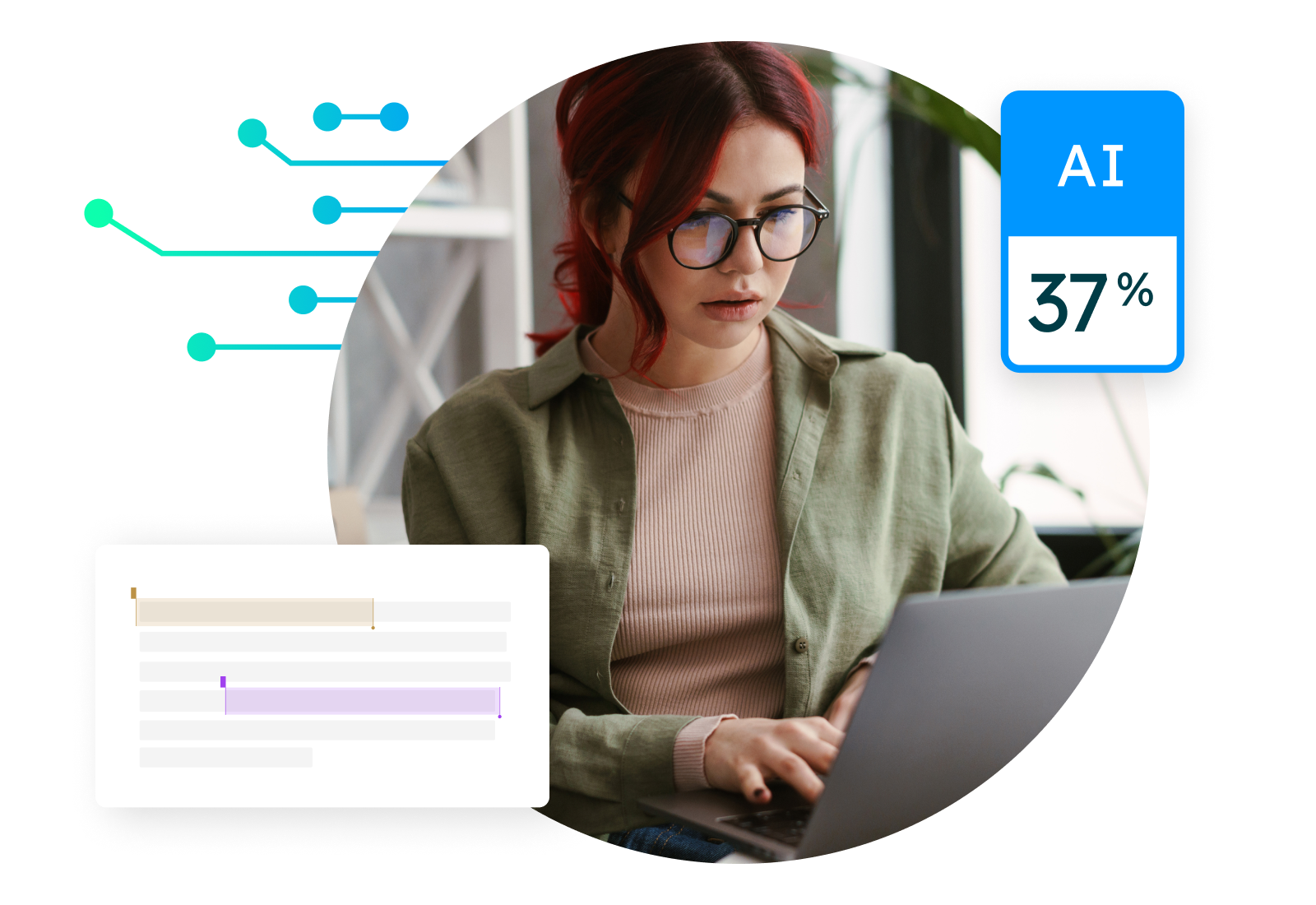
Student success starts here
Uphold academic integrity.
Ensure original work from students and address even the most sophisticated potential misconduct.
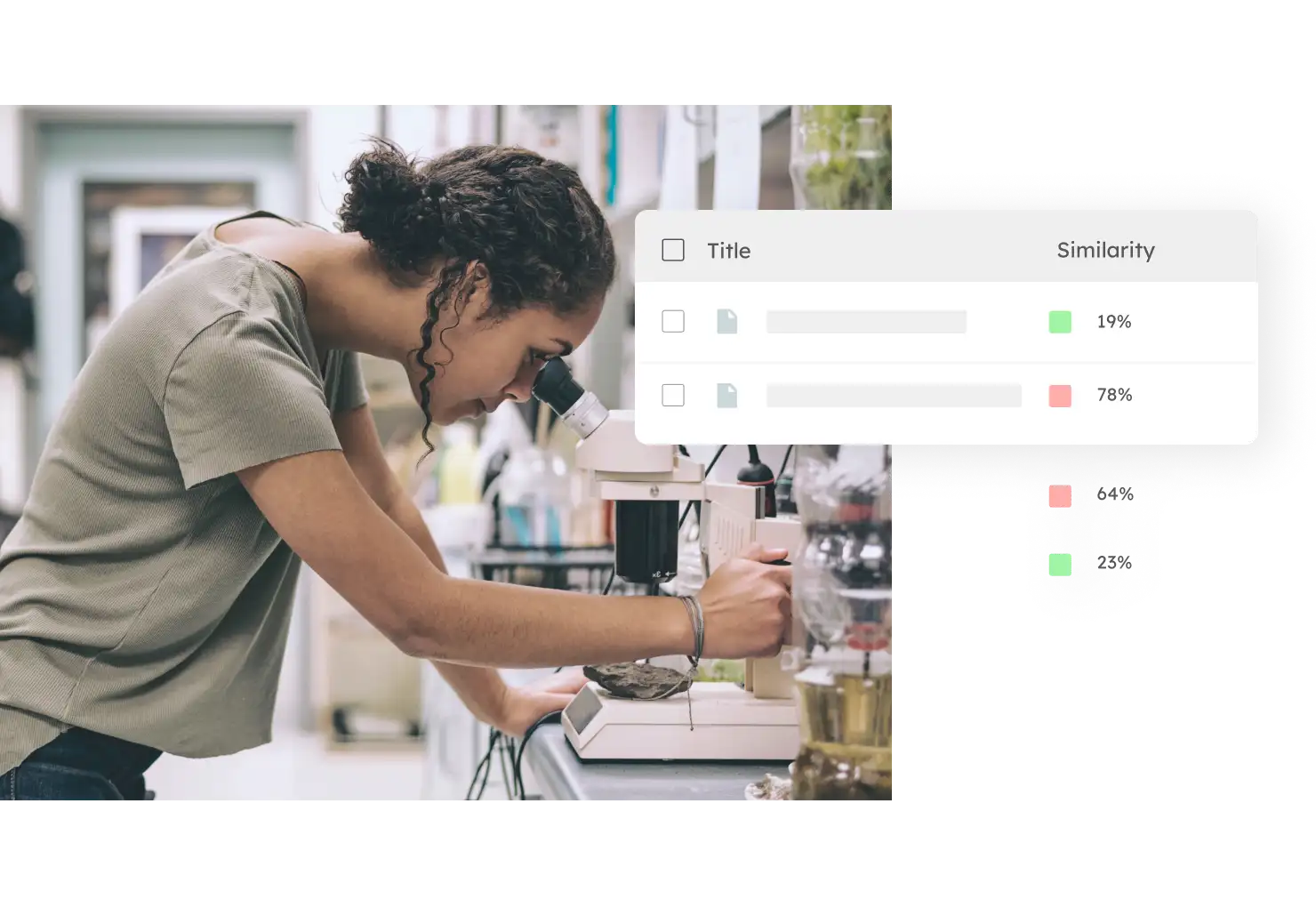
Innovative assessments. Strategic insights.
Flexible solutions giving educators the freedom to design and deliver student assessments their way – with integrity and confidence.
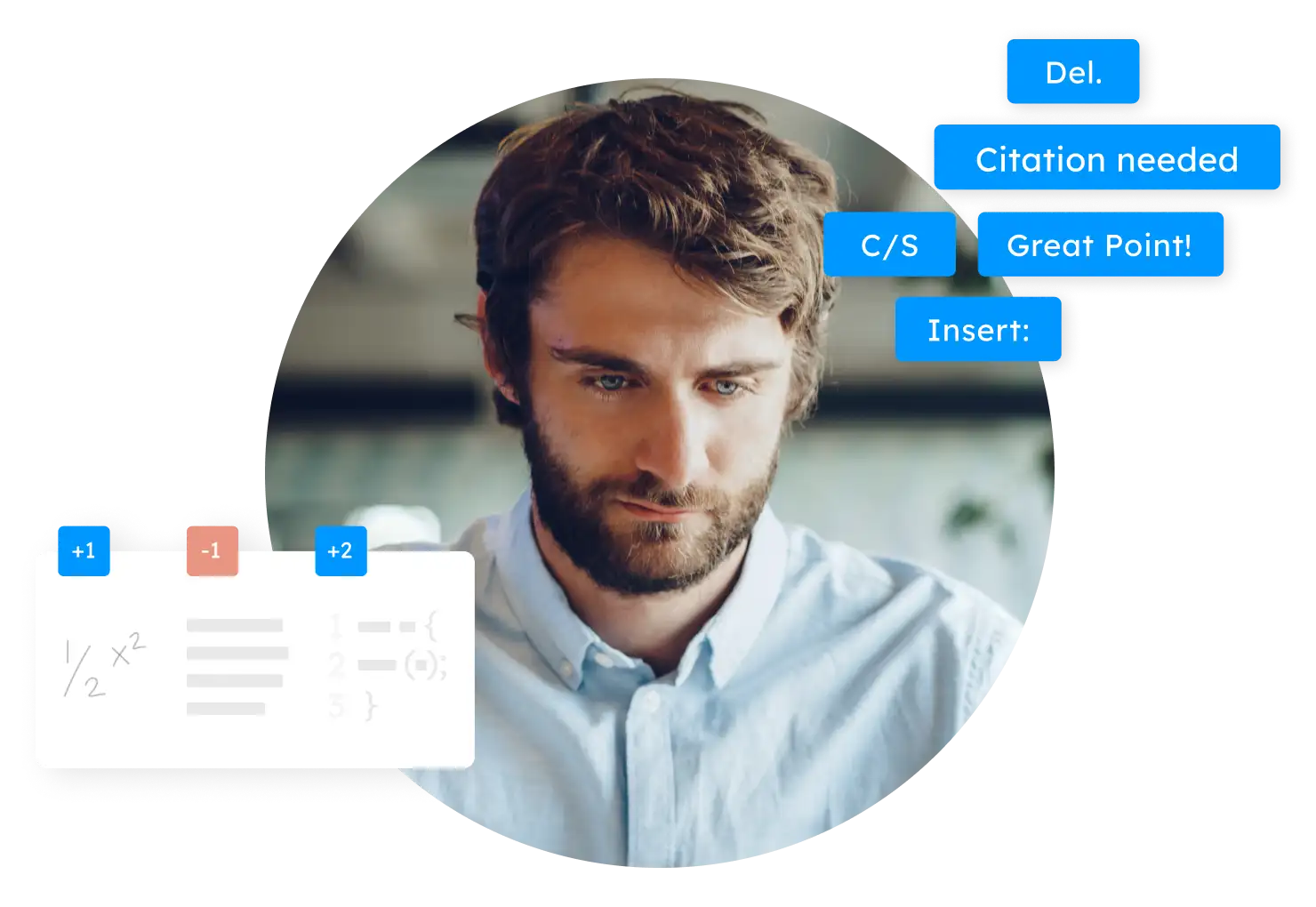
Foster original thinking
Help develop students’ original thinking skills with high-quality, actionable feedback that fits easily into teachers’ existing workflows.
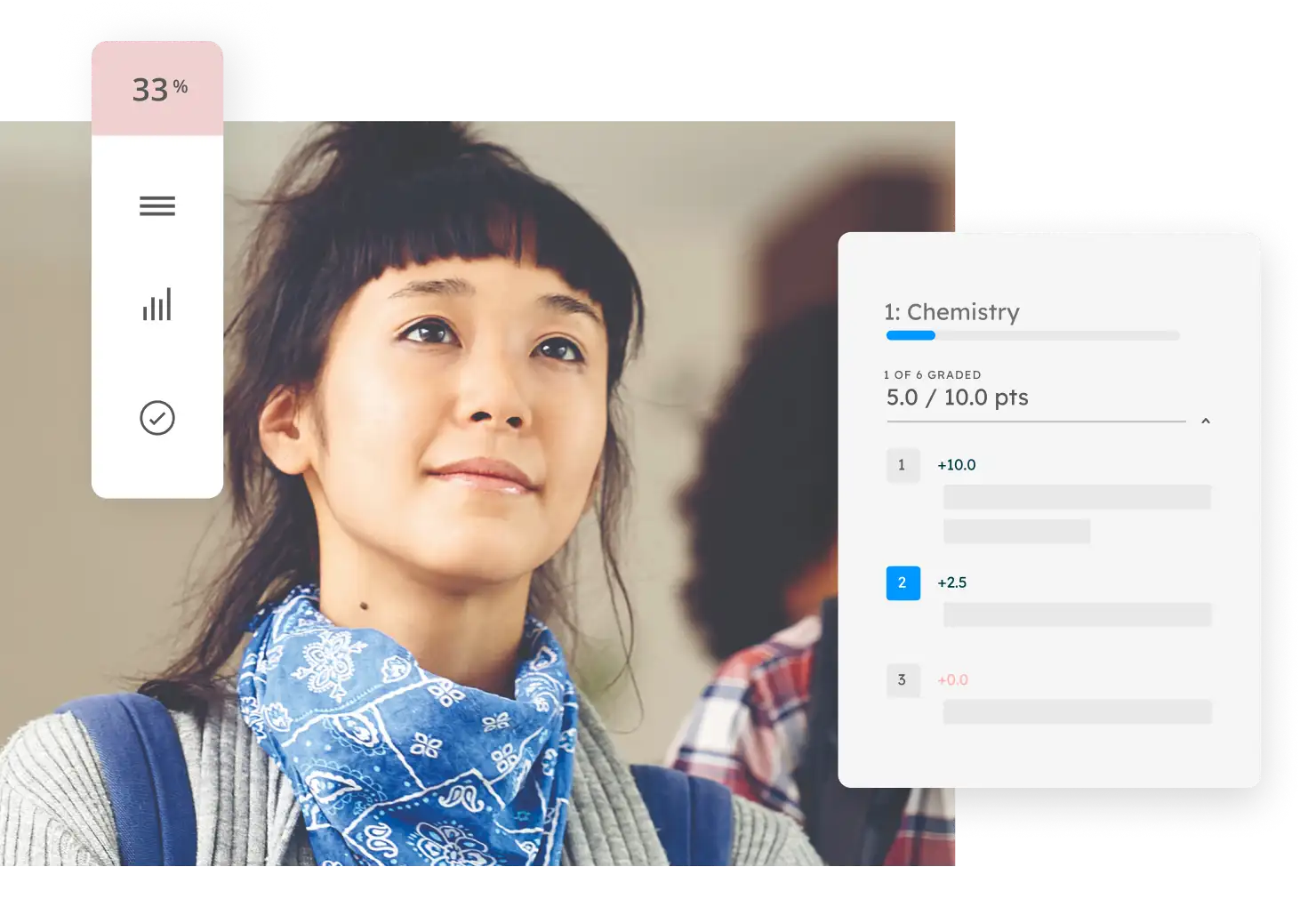
Customer stories
University of leeds widely adopts gradescope for online assessment.
With campuswide digital transformation in mind, rollout to thousands of faculty across disciplines took only two months, far quicker than anticipated.
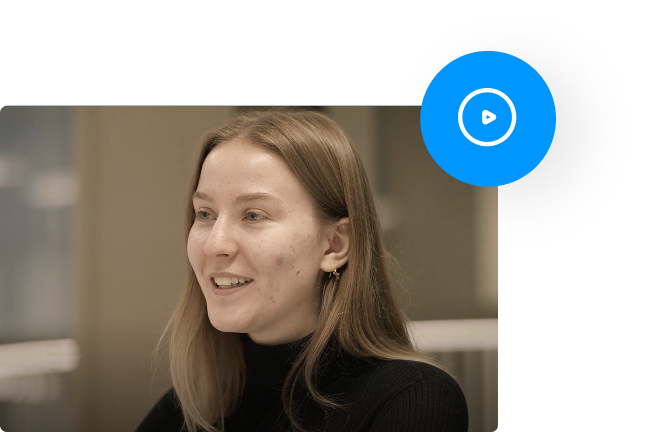
University of Maryland Global Campus builds a culture of academic integrity by pairing policy with technology
Keeping student and instructor needs at the core is key to upholding their rigorous standards of integrity while centering students in their learning.
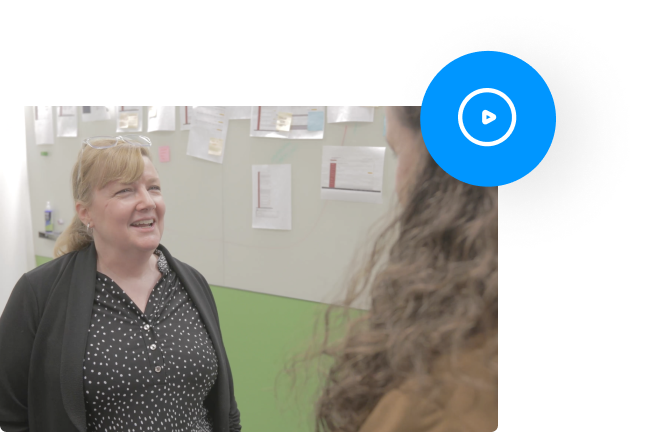
Solutions made just for you


See solutions for Higher Education
Prepare students for success with tools designed to uphold academic integrity and advance assessment.
See solutions for Secondary Education
Help students develop original thinking skills with tools that improve their writing and check for similarities to existing works.
See solutions for Research and Publication
The rigorous academic research and publishing process gets a trusted tool to ensure the originality of scholarly work.
Keep integrity at the core of every assessment.
Everything you need no matter how or where you assess student work.
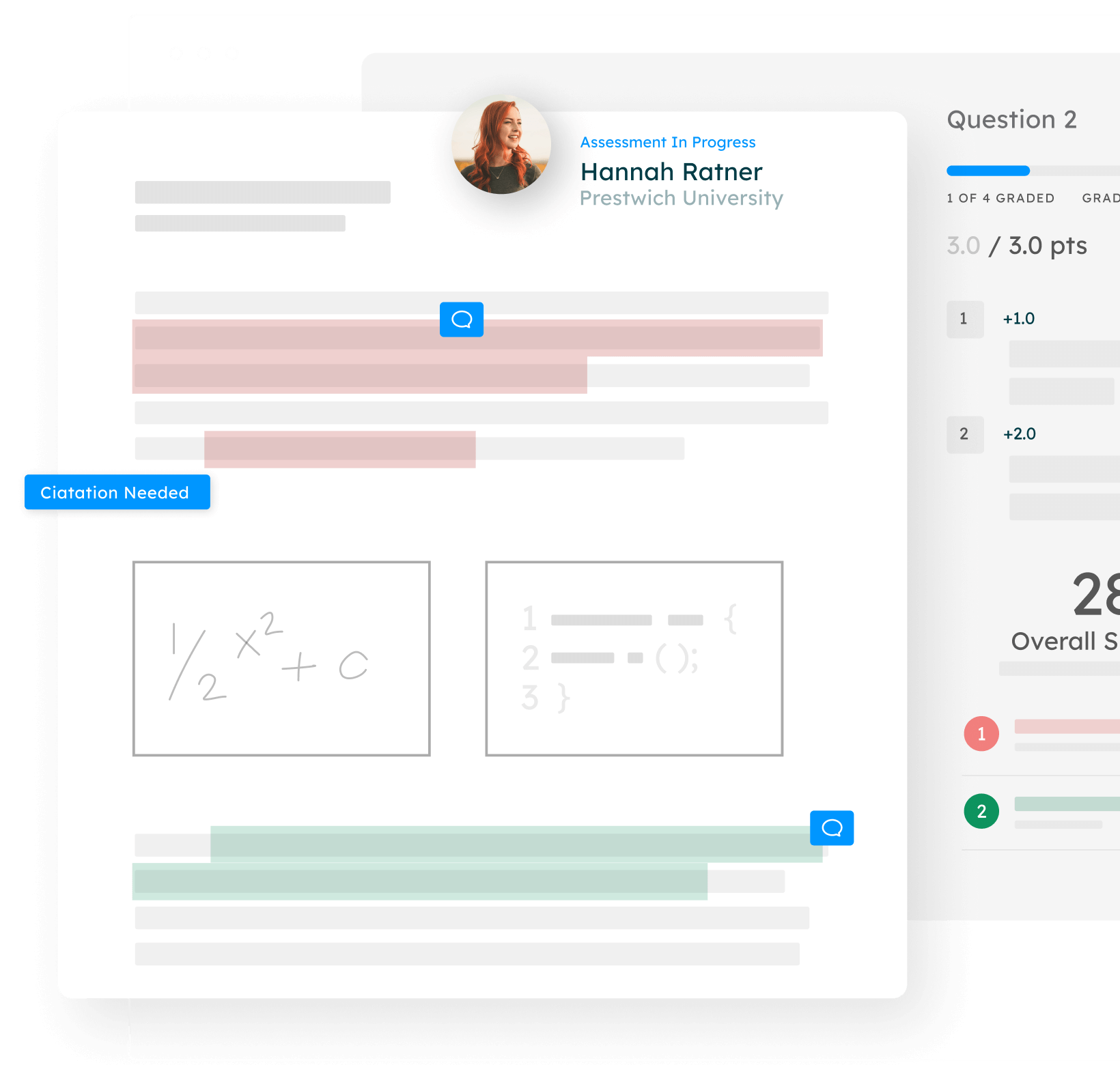
Feedback Studio
Give feedback and grade essays and long-form writing assignments with the tool that fosters writing excellence and academic integrity.
Originality
Check for existing as well as new forms of plagiarism - from text similarity and synonym swapping to contract cheating, AI writing, and AI paraphrasing.
Grade paper-based, bubble sheet, and code assignments faster than ever while giving more robust feedback and gaining valuable insights.
Address potential gaps in curriculum and assessment to prepare students for their careers and meet accreditation requirements.
This robust, comprehensive plagiarism checker fits seamlessly into existing workflows.
iThenticate
Screen personal statements for potential plagiarism and ensure the highest level of integrity before matriculation.
The Turnitin difference

Complete Coverage
Your coverage is comprehensive, with the largest content database of scholarly content, student papers, and webpages.
Extensive Support
Have the help you need with 24/7 tech support, curricular resources created by real educators, and customized training and onboarding services.
Human-Centered AI
Our people-centered approach to artificial intelligence improves academic integrity and makes assessment better for all.
Unparalleled Access
Access Turnitin tools at scale through integrations with over 100 systems in the educational ecosystem.
Further Reading
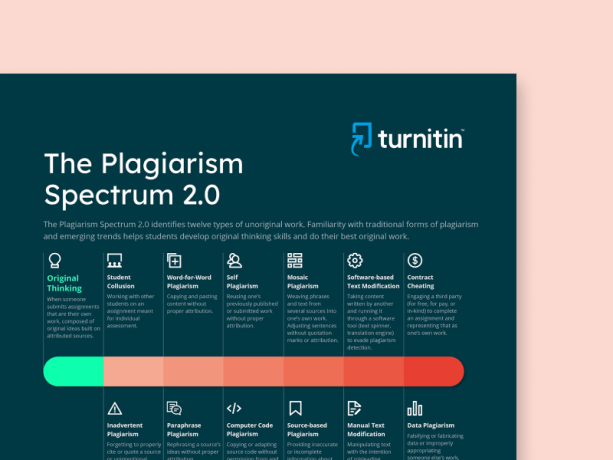
The Plagiarism Spectrum 2.0 identifies twelve types of unoriginal work — both traditional forms of plagiarism and emerging trends. Understanding these forms of plagiarism supports the development of original thinking skills and helps students do their best, original work.
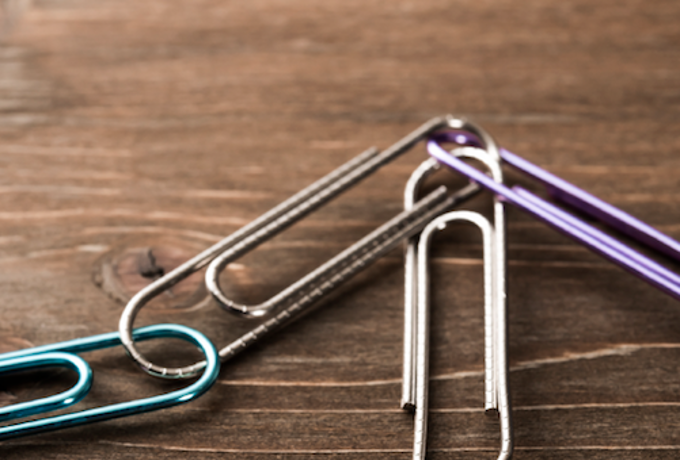
An educator guide providing suggestions for how to adapt instruction when faced with student use of AI.
for Education
- Google Classroom
- Google Workspace Admin
- Google Cloud
Check for missing citations quickly and easily with originality reports
Originality reports use the power of Google Search to help students properly integrate external inspiration into their writing – while making it easy for instructors to check for potential plagiarism.
Help teachers quickly assess authenticity
Compare student work against hundreds of billions of web pages and over 40 million books with a single click
Highlight potential plagiarism and link to external sources within your grading interface
Get answers quickly and avoid manually searching for web matches
Help students turn in their best work
Enable students to check their own work for recommended citations up to three times before submitting
Help students learn to build on outside ideas and properly incorporate them into their work
Run originality reports in multiple languages .
Coming soon Backfill results for your school’s corpus of work in originality reports.
Compare student work without compromising privacy
Compare student-to-student matches against your domain-owned repository of past work when you sign up for the Teaching and Learning Upgrade or Google Workspace for Education Plus
Admins can add or delete files from the school repository manually
You always own your data — it’s our responsibility to keep it more secure
Coming soon Support for Microsoft Word documents in originality reports.
Learn about access to originality reports
Google workspace for education fundamentals.
Instructors using Classroom and Assignments in Google Workspace for Education Fundamentals can enable up to five originality reports per class at no cost.
- Get Google Workspace
Teaching and Learning Upgrade and Education Plus
Instructors with the Teaching and Learning Upgrade or Education Plus licenses get unlimited originality reports and the ability to make student-to-student comparisons on your domain-owned repository of past submissions.
- Contact sales
Explore resources to get up and running
Discover helpful resources to assist you with originality reports and get helpful answers to common questions on originality reports.
Originality reports overview
Learn more about originality reports for educators and students.
- Download overview
How to use originality reports
This tutorial shows how you and your students can use originality reports.
- Watch video
Originality reports help
Explore helpful answers to common questions on originality reports.
Originality reports and privacy
Learn how originality reports protect the privacy of all users, adhering to rigorous compliance standards.
Use originality reports with Classroom
Access originality reports through Classroom, a tool that helps students and teachers organize assignments, boost collaboration, and foster better communication.
- Explore Classroom
Use originality reports with Assignments
Do you have another learning management system? Access originality reports through Assignments, an add-on application for your LMS to distribute, analyze, and grade student work.
- Explore Assignments
Get unlimited access to originality reports with the Teaching and Learning Upgrade and Education Plus
You're now viewing content for a different region..
For content more relevant to your region, we suggest:
Sign up here for updates, insights, resources, and more.
Free plagiarism checker by EasyBib
Check for plagiarism, grammar errors, and more.
- Expert Check
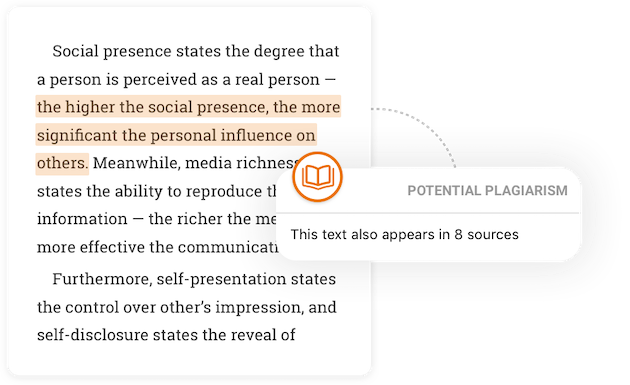
Check for accidental plagiarism
Avoid unintentional plagiarism. Check your work against billions of sources to ensure complete originality.
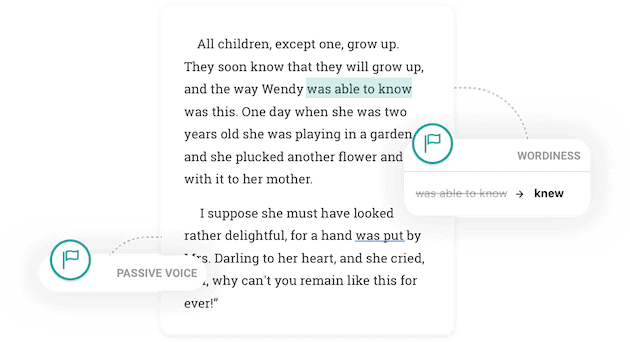
Find and fix grammar errors
Turn in your best work. Our smart proofreader catches even the smallest writing mistakes so you don't have to.
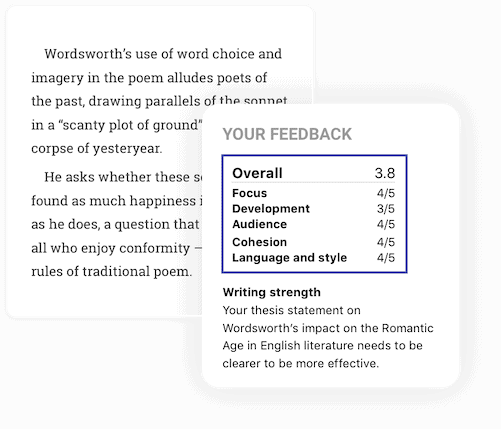
Get expert writing help
Improve the quality of your paper. Receive feedback on your main idea, writing mechanics, structure, conclusion, and more.
What students are saying about us

"Caught comma errors that I actually struggle with even after proofreading myself."
- Natasha J.

"I find the suggestions to be extremely helpful especially as they can instantly take you to that section in your paper for you to fix any and all issues related to the grammar or spelling error(s)."
- Catherine R.
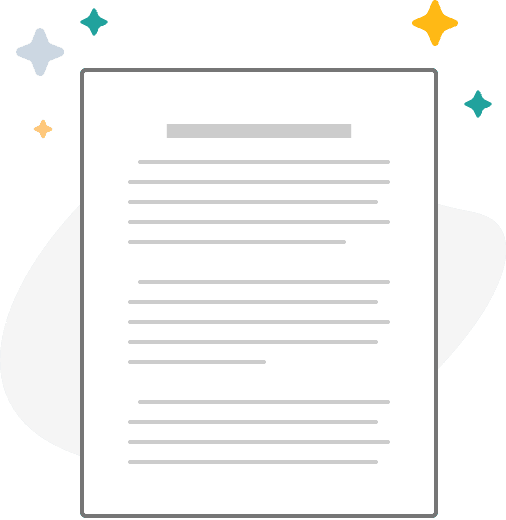
Check for unintentional plagiarism
Easily check your paper for missing citations and accidental plagiarism with the EasyBib plagiarism checker. The EasyBib plagiarism checker:
- Scans your paper against billions of sources.
- Identifies text that may be flagged for plagiarism.
- Provides you with a plagiarism score.
You can submit your paper at any hour of the day and quickly receive a plagiarism report.
What is the EasyBib plagiarism checker?
Most basic plagiarism checkers review your work and calculate a percentage, meaning how much of your writing is indicative of original work. But, the EasyBib plagiarism checker goes way beyond a simple percentage. Any text that could be categorized as potential plagiarism is highlighted, allowing you time to review each warning and determine how to adjust it or how to cite it correctly.
You’ll even see the sources against which your writing is compared and the actual word for word breakdown. If you determine that a warning is unnecessary, you can waive the plagiarism check suggestion.
Plagiarism is unethical because it doesn’t credit those who created the original work; it violates intellectual property and serves to benefit the perpetrator. It is a severe enough academic offense, that many faculty members use their own plagiarism checking tool for their students’ work. With the EasyBib Plagiarism checker, you can stay one step ahead of your professors and catch citation mistakes and accidental plagiarism before you submit your work for grading.
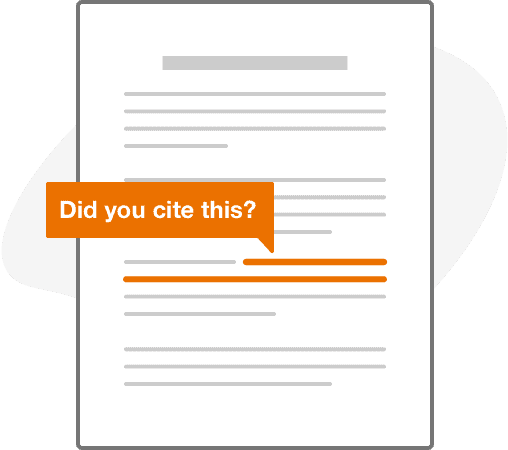
Why use a plagiarism checker?
Imagine – it’s finals week and the final research paper of the semester is due in two days. You, being quite familiar with this high-stakes situation, hit the books, and pull together a ten-page, last-minute masterpiece using articles and materials from dozens of different sources.
However, in those late, coffee-fueled hours, are you fully confident that you correctly cited all the different sources you used? Are you sure you didn’t accidentally forget any? Are you confident that your teacher’s plagiarism tool will give your paper a 0% plagiarism score?
That’s where the EasyBib plagiarism checker comes in to save the day. One quick check can help you address all the above questions and put your mind at ease.
What exactly is plagiarism?
Plagiarism has a number of possible definitions; it involves more than just copying someone else’s work. Improper citing, patchworking, and paraphrasing could all lead to plagiarism in one of your college assignments. Below are some common examples of accidental plagiarism that commonly occur.
Quoting or paraphrasing without citations
Not including in-text citations is another common type of accidental plagiarism. Quoting is taking verbatim text from a source. Paraphrasing is when you’re using another source to take the same idea but put it in your own words. In both cases, it’s important to always cite where those ideas are coming from. The EasyBib plagiarism checker can help alert you to when you need to accurately cite the sources you used.
Patchwork plagiarism
When writing a paper, you’re often sifting through multiple sources and tabs from different search engines. It’s easy to accidentally string together pieces of sentences and phrases into your own paragraphs. You may change a few words here and there, but it’s similar to the original text. Even though it’s accidental, it is still considered plagiarism. It’s important to clearly state when you’re using someone else’s words and work.
Improper citations
Depending on the class, professor, subject, or teacher, there are multiple correct citation styles and preferences. Some examples of common style guides that are followed for citations include MLA, APA, and Chicago style. When citing resources, it’s important to cite them accurately. Incorrect citations could make it impossible for a reader to track down a source and it’s considered plagiarism. There are EasyBib citation tools to help you do this.
Don’t fall victim to plagiarism pitfalls. Most of the time, you don’t even mean to commit plagiarism; rather, you’ve read so many sources from different search engines that it gets difficult to determine an original thought or well-stated fact versus someone else’s work. Or worse, you assume a statement is common knowledge, when in fact, it should be attributed to another author.
When in doubt, cite your source!
Time for a quick plagiarism quiz!
Which of the following requires a citation?
- A chart or graph from another source
- A paraphrase of an original source
- Several sources’ ideas summarized into your own paragraph
- A direct quote
- All of the above
If you guessed option E than you’d be correct. Correct punctuation and citation of another individual’s ideas, quotes, and graphics are a pillar of good academic writing.
What if you copy your own previous writing?
Resubmitting your own original work for another class’s assignment is a form of self-plagiarism, so don’t cut corners in your writing. Draft an original piece for each class or ask your professor if you can incorporate your previous research.
What features are available with the EasyBib plagiarism checker?
Along with providing warnings and sources for possible plagiarism, the EasyBib plagiarism checker works alongside the other EasyBib tools, including a grammar checker and a spell checker . You’ll receive personalized feedback on your thesis and writing structure too!
The plagiarism checker compares your writing sample with billions of available sources online so that it detects plagiarism at every level. You’ll be notified of which phrases are too similar to current research and literature, prompting a possible rewrite or additional citation. You’ll also get feedback on your paper’s inconsistencies, such as changes in text, formatting, or style. These small details could suggest possible plagiarism within your assignment.
And speaking of citations, there are also EasyBib citation tools available. They help you quickly build your bibliography and avoid accidental plagiarism. Make sure you know which citation format your professor prefers!
Great! How do I start?
Simply copy and paste or upload your essay into the checker at the top of this page. You’ll receive the first five grammar suggestions for free! To try the plagiarism checker for free, start your EasyBib Plus three-day free trial.* If you love the product and decide to opt for premium services, you’ll have access to unlimited writing suggestions and personalized feedback.
The EasyBib plagiarism checker is conveniently available 24 hours a day and seven days a week. You can cancel anytime. Check your paper for free today!.
*See Terms and Conditions
Visit www.easybib.com for more information on helpful EasyBib writing and citing tools.
For informational guides and on writing and citing, visit the EasyBib guides homepage .
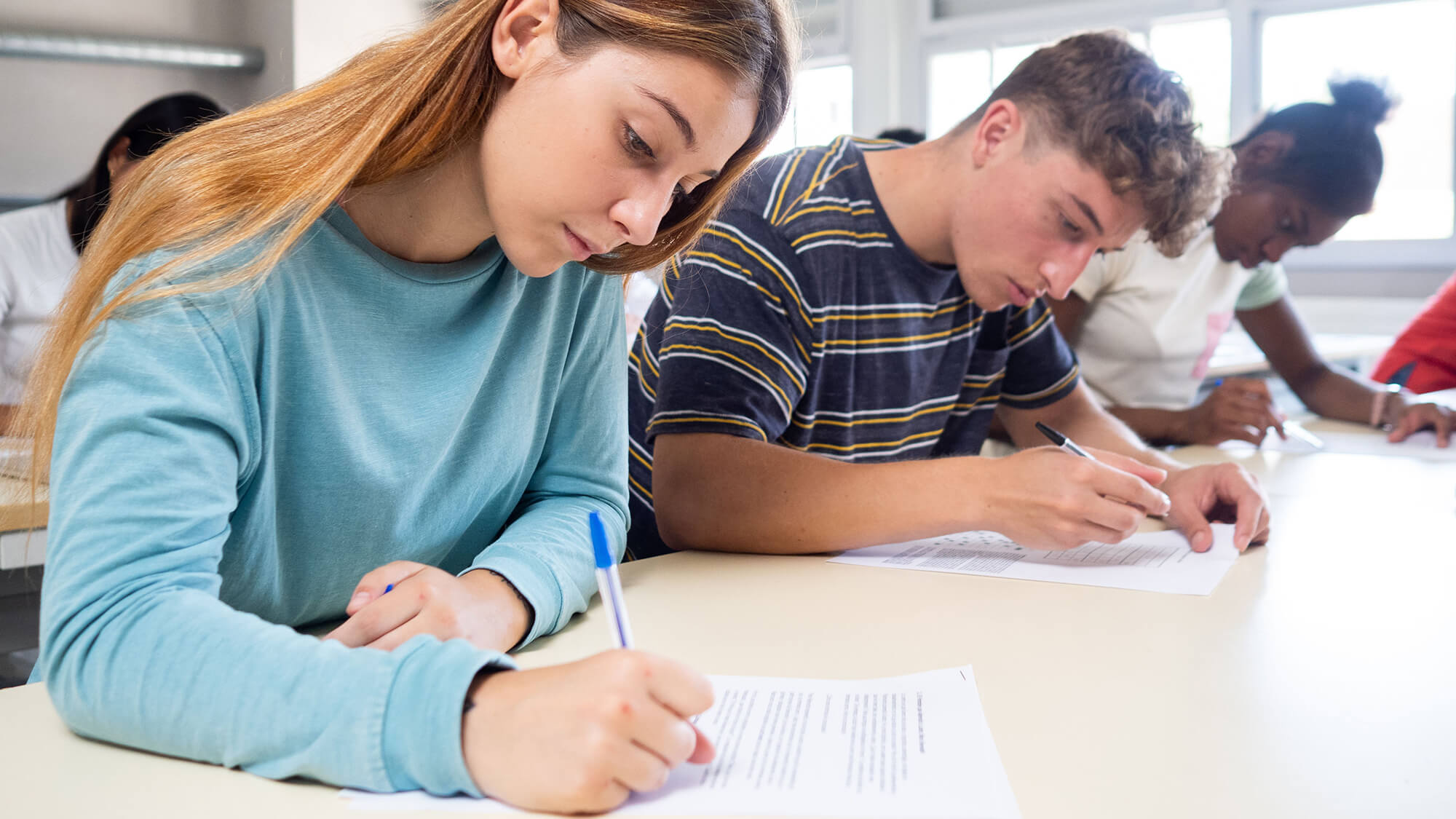
How To Avoid Plagiarism In Assignments? A Guide For Beginners
May 01, 2022 :: v.chuprii
Plagiarism is a common problem in assignments. So, how should beginners try to avoid it?
Plagiarism can cause a lot of problems for not only the student but also the institution. Therefore, it’s no surprise many students and teachers work alike to get rid of it. Because a study revealed that 36% of the students admitted that they plagiarized without citing the source.
This is a number from a study conducted a few years ago, as they continue to fluctuate. But that doesn’t mean plagiarism doesn’t happen today. In the pandemic era, it’s even more common than it was before.
So, what should students do to avoid it in their assignments? First, let’s talk about a few essential aspects and then understand how to find and remove plagiarism.
What Is Plagiarism?
Plagiarism is simply copying another writer’s content and pasting it into your own. However, besides copying content word-to-word, Oxford puts it exactly how it is as plagiarism is also about “ presenting someone else’s ideas as your own .”
Therefore, plagiarism isn’t just about copying and pasting something; it’s also about copying an original idea without crediting the original author or owner of the content. This makes content unrightfully copied or taken and ridding the original author of any sort of recognition.
That’s why, regardless of the environment, plagiarism is considered an unethical and unacceptable practice—even if it’s unintentional.
Types Of Plagiarism To Look For
While the basis of plagiarism remains the same, its types can change. That’s why it’s imperative to understand the variable plagiarism and how you need to look for it. But, before we talk about finding it, let’s understand the four main types of plagiarism:
Direct/Complete Plagiarism
The most common and perhaps the most unethical type is direct plagiarism. In this one, the writer copies another writer’s entire work without giving him credit, making changes, or doing their own research.
Source-based Plagiarism
Source-based plagiarism is when a writer cites a source that does not exist. This leads to misinformation and is considered one of the most unethical practices in the world of the writing of any sort.
Mosaic Or Patchwork
Mosaic or patchwork plagiarism is the most elusive type of plagiarism as it can be difficult to detect. In this one, a writer makes only a few changes to the original content so that it can avoid a plagiarism checker. Nowadays, AI can easily catch this type as well.
Accidental Plagiarism
Accidental plagiarism is when a writer unintentionally writes something that coincides with another writer’s work. This is common in similar or very standard topics, but students should still avoid it.
3 Consequences of Plagiarism
In the academic setting, the consequences of plagiarism are plain and simple. You would either fail your assignment or your exam. But the trail that plagiarism leaves behind can follow you into your career. To help you understand, here are three main consequences of plagiarism.
- Reduced Grades
Grades are one of the first things that’ll feel the effects of plagiarism. In many academies around the globe, the everyday assignment of a student is a major part of their grading at the end of the academic year.
Therefore, if your academic year has one or more instances of plagiarism of any kind, then it’ll affect your grades—in other words, it’ll cause them to go down to an unacceptable level.
- Abridged Respect
Your grades will suffer later, but first, your respect will be tarnished in the eyes of your tutors. You won’t only avoid any sort of credibility, but it will also put your assignments at the bottom of the priority list.
- Career Consequences
The most delayed consequence of plagiarism will be on your career. For a student that committed plagiarism a lot during their academic year will not only face problems in their career but might be at a loss when faced with important aspects of their careers.
Benefits Of Avoiding Plagiarism
Just like there are consequences to it, there are benefits to avoiding it. Here is why it’s important to get rid of plagiarism from your assignments:
- Credibility
You need to ensure your credibility as a student, and for that, you need to present original assignments. Therefore, finding and removing plagiarism is your responsibility.
- Shows Proper Research
Whenever you turn in an original and plagiarism-free assignment, it will portray your research skills.
- Portrays Critical Thinking
When you submit an original assignment, it also portrays critical thinking. As a student, this is more valuable to you than anything else, as it’s a skill you’ll need in your career.
5-Step Process Of Avoiding Plagiarism
Avoiding plagiarism is a process spread across a few parts. In order to remove it from your content, you need to find it first. If there’s no plagiarism, then you’re good to go.
But, if there is, then you need to remove it accordingly before you pass your assignment along. Therefore, let’s dive right into it and see the five steps of removing plagiarism:
- Use A Plagiarism Checker
The first step is to find a plagiarism checker free. This checker should be able to conduct a deep search across the internet to help you find any sort of duplicity in your content. Here’s the one we’ve picked:
We’ve uploaded the content to check if it has any sort of plagiarism. As you can notice, the plagiarism finder allows searching for up to 1000 words at a time. So, you might have to scan your content in parts. Once you do, you might find this:
As seen here, this part of the content is 100% plagiarized. Therefore, it must be rephrased or removed from our content.
- Analyze The Source Of Plagiarism & Note It Down
A good thing about plagiarism checkers today is that they help you find the source of plagiarism. In other words, where the original content was posted. Understanding the source of plagiarism is an important step in removing it.
Here we see the same plagiarism checker provide us with the websites from where the content was copied. We’ll be noting these down before we remove or rewrite our content.
- Rewrite Or Rephrase Plagiarized Parts
Now you’ll need a paraphraser. Since rewriting a few hundred words of content can be a challenge, using a rephraser will help us save time and remove plagiarism effectively.
You can see the difference in content by using a paraphraser. It helped us save time by rewriting the majority of our content. We can use this to avoid plagiarism, but there are still two more steps to go.
Furthermore, you can try various content tone types to ensure that the rephrased content matches your content tone.
- Cite The Source Or Quote Where Necessary
Now that the content has been rephrased, we will be using the sources we found as citations. This will help us remove plagiarism effectively, as citing the original author will give the credit where it’s due. So, try to use MLA, APA, or Chicago styles of citation once you’re done rewriting.
- Check For Plagiarism Again
Now that we’ve removed plagiarism by rewriting, the only step that remains is to check for it again. Once you do, this is what you should see:
As you can see, our content is now 100% original or unique, as said by the plagiarism finder.
Conclusion
This is the process of avoiding plagiarism, folks. You must use a plagiarism checker to find any duplicate content in your assignments and then use the rest of the process to avoid it before passing it on.
Related articles

get started.
Full Transparency
We might not be your best fit. If that’s the case, we will let you know.
Browser Error
Oh snap! This course has many interactive elements that don't work well on Internet Explorer or older versions of Firefox. Please use Google Chrome, Firefox version 61+, or Safari to complete this training. This training is also optimized for mobile devices.
It is a violation of academic integrity to present someone else’s work as your own. That means:
- You cannot buy a completed assignment from someone else on the internet.
- You cannot reuse an assignment that someone else completed in a previous semester.
- You cannot pay your roommate to complete your assignment for you.
- You cannot crowdsource your assignment, either online or in real life.
- You cannot avail yourself of any of the many, many other creative ways to get around actually doing the work yourself.
Your instructors notice when your writing differs from your typical style. They have access to anti-plagiarism resources like Turnitin . They know how to search the Internet. In general, they are highly educated people who are very intelligent. If you copy, either part of your assignment or the whole thing, the chances of your getting caught are a lot higher than you might think.
- Courses Home
- Academic Integrity
- What is Academic Integrity?
- Intentional Violations
- Artificial Intelligence
- Other Serious Violations
- Academic Integrity Violations Process
- User Dashboard
- Account guides
- Administrator’s guide — How to set up an integration
Instructor’s guide — How to create assignments with PlagiarismCheck
- Instructor’s guide — How to see submissions and access Similarity & AI reports
- Students’ guide — How to submit assignments and see Similarity & AI scores
- Google Classroom
Welcome to a quick guide about using PlagiarismCheck in Brightspace LMS!
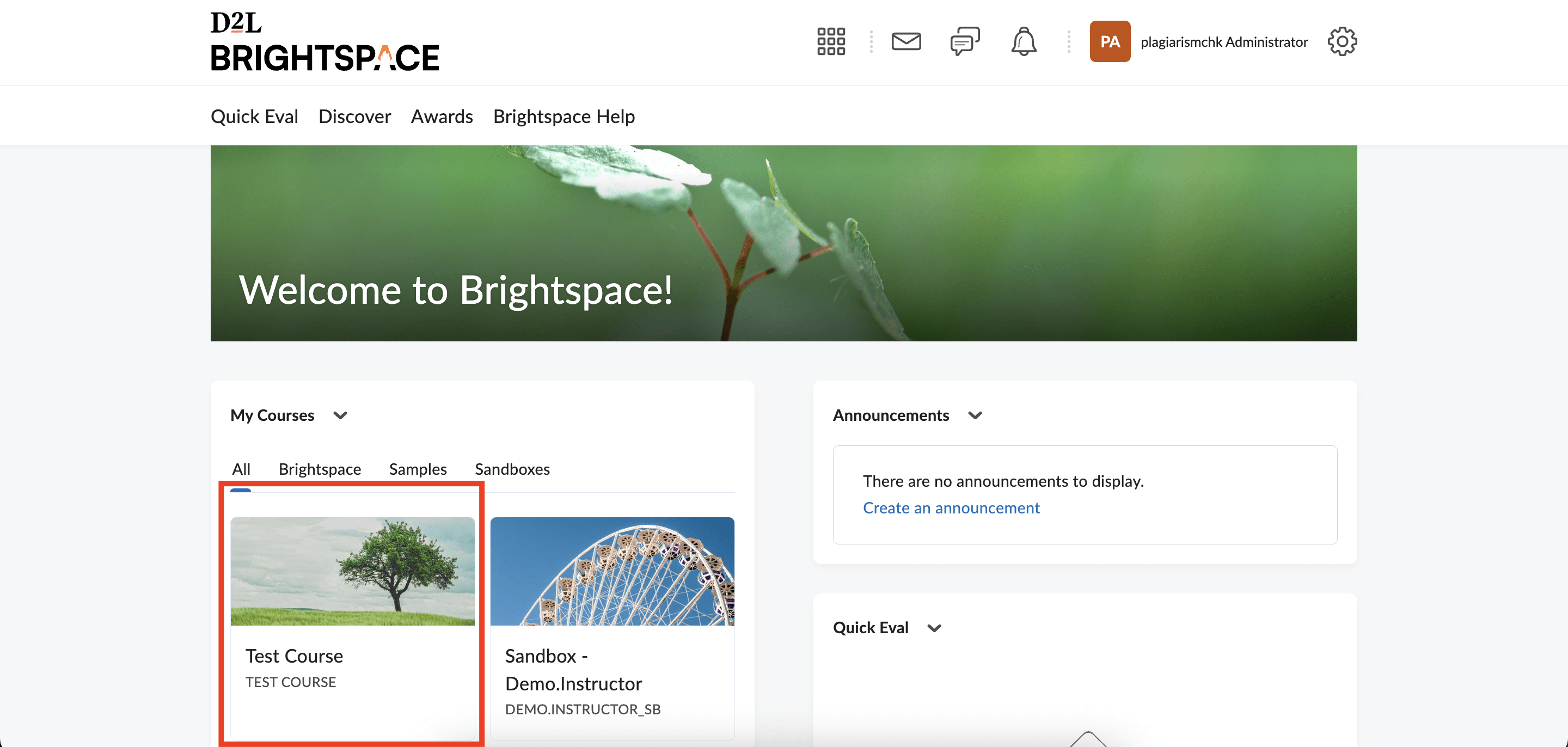
- Before publishing this assignment, you can configure how a similarity report will look like:
- Exclude sources with less than % — allows you to exclude sources from an overall similarity score, which are equal or less than a percentage you choose. You will see them on the list of sources as inactive, but you can make them active on a report.
- Include references — by default we do not include in an overall similarity the text formatted as references. Tick this checkbox if you would like such text to be included.
- Include quotes — by default we do not include in an overall similarity the text formatted as quotes. Tick this checkbox if you would like such text to be included.
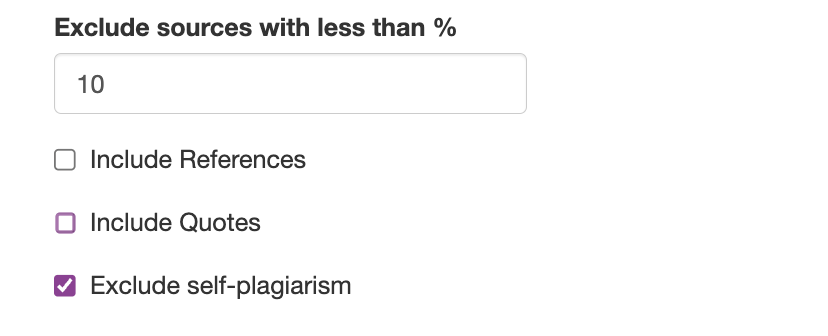
10. When ready, click “Publish” in the top-right corner of this page.
Read about how to see student’s submissions and access similarity reports here
Should you have any questions, please contact [email protected].

The document is loaded and is now being checked for plagiarism.
Go to profile
To continue, please provide your email adress. Already have an account? Please use Sign In
Use of this website establishes your agreement to our Terms & Privacy Policy , and to receiving product-related emails, which you can unsubscribe from at any time.
Not a member? Create Account
Email Address
Reset password
To continue, please enter your email
Choose a new password
New password
Confirm new password
We'll be glad to know what you like or dislike about our website. Let us know about your suggestions concerning service enhancement, or any technical difficulties you are experiencing.
Your message
Continue to check the text
Are you a professor, teacher, instructor, or tutor in the education sector? Your thoughts are highly welcome!
Click here or email [email protected] to say what you think on the topic. Make sure your subject line is "Unobvious plagiarism consequences."
Please, include:
- your 50-100 words long answer
- your full name, short bio, country and personal blog or website
If your response adds value, we will add it to this original post.
Shopping cart
One step to the finish, find out more about our products and solutions.
- For teachers
- How it works
- Turnitin Checker for Students
- AI Plagiarism Checker
- AI Content Detector with API integration
- User guides
- Customer reviews
- API documentation
- Brightspace integration
- Canvas integration
- Moodle integration
- Schoology integration
- Google classroom integration
- Google docs add-on
- [email protected]
- +1 844 319 5147 (24/7)

- Plagiarism check free
- Best similarity checking app
- Plagiarism detector for canvas
- Plagiarism checking tool for moodle
- Plagiarism detector for google classroom
- Terms & Conditions
- Privacy Policy
- Cookie Policy
- Refund policy
New Data Reveal How Many Students Are Using AI to Cheat

- Share article
AI-fueled cheating—and how to stop students from doing it—has become a major concern for educators.
But how prevalent is it? Newly released data from a popular plagiarism-detection company is shedding some light on the problem.
And it may not be as bad as educators think it is.
Of the more than 200 million writing assignments reviewed by Turnitin’s AI detection tool over the past year, some AI use was detected in about 1 out of 10 assignments, while only 3 out of every 100 assignments were generated mostly by AI.
These numbers have not changed much from when Turnitin released data in August of 2023 about the first three months of the use of its detection tool, said the company’s chief product officer, Annie Chechitelli.
“We hit a steady state, and it hasn’t changed dramatically since then,” she said. “There are students who are leaning on AI too much. But it’s not pervasive. It wasn’t this, ‘the sky is falling.’”
The fact that the number of students using AI to complete their schoolwork hasn’t skyrocketed in the past year dovetails with survey findings from Stanford University that were released in December. Researchers there polled students in 40 different high schools and found that the percentage of students who admitted to cheating has remained flat since the advent of ChatGPT and other readily available generative AI tools. For years before the release of ChatGPT, between 60 and 70 percent of students admitted to cheating, and that remained the same in the 2023 surveys, the researchers said.
Turnitin’s latest data release shows that in 11 percent of assignments run through its AI detection tool that at least 20 percent of each assignment had evidence of AI use in the writing. In 3 percent of the assignments, each assignment was made up of 80 percent or more of AI writing, which tracks closely with what the company was seeing just 3 months after it launched its AI detection tool .
Experts warn against fixating on cheating and plagiarism
However, a separate survey of educators has found that AI detection tools are becoming more popular with teachers, a trend that worries some experts.
The survey of middle and high school teachers by the Center for Democracy and Technology, a nonprofit focused on technology policy and consumer rights, found that 68 percent have used an AI detection tool, up substantially from the previous year. Teachers also reported in the same survey that students are increasingly getting in trouble for using AI to complete assignments. In the 2023-24 school year, 63 percent of teachers said students had gotten in trouble for being accused of using generative AI in their schoolwork, up from 48 percent last school year.

Despite scant evidence that AI is fueling a wave in cheating, half of teachers reported in the Center for Democracy and Technology survey that generative AI has made them more distrustful that their students are turning in original work.
Some experts warn that fixating on plagiarism and cheating is the wrong focus.
This creates an environment where students are afraid to talk with their teachers about AI tools because they might get in trouble, said Tara Nattrass, the managing director of innovation and strategy at ISTE+ASCD, a nonprofit that offers content and professional development on educational technology and curriculum.
“We need to reframe the conversation and engage with students around the ways in which AI can support them in their learning and the ways in which it may be detrimental to their learning,” she said in an email to Education Week. “We want students to know that activities like using AI to write essays and pass them off as their own is harmful to their learning while using AI to break down difficult topics to strengthen understanding can help them in their learning.”
Shift the focus to teaching AI literacy, crafting better policies
Students said in the Stanford survey that is generally how they think AI should be used: as an aid to understanding concepts rather than a fancy plagiarism tool.
Nattrass said schools should be teaching AI literacy while including students in drafting clear AI guidelines.
Nattrass also recommends against schools using AI detection tools. They are too unreliable to authenticate students’ work, she said, and false positives can be devastating to individual students and breed a larger environment of mistrust. Some research has found that AI detection tools are especially weak at identifying the original writing of English learners from AI-driven prose.
“Students are using AI and will continue to do so with or without educator guidance,” Nattrass said. “Teaching students about safe and ethical AI use is a part of our responsibility to help them become contributing digital citizens.”
AI detection software actually uses AI to function: these tools are trained on large amounts of machine- and human-created writing so that the software can ideally recognize differences between the two.
Turnitin claims that its AI detector is 99 percent accurate at determining whether a document was written with AI, specifically ChatGPT, as long as the document was composed with at least 20 percent of AI writing, according to the company’s website.
Chechitelli pointed out that no detector or test—whether it’s a fire alarm or medical test—is 100 percent accurate.
While she said teachers should not rely solely on AI detectors to determine if a student is using AI to cheat, she makes the case that detection tools can provide teachers with valuable data.
“It is not definitive proof,” she said. “It’s a signal that taken with other signals can be used to start a conversation with a student.”
As educators become more comfortable with generative AI, Chechitelli said she predicts the focus will shift from detection to transparency: how should students cite or communicate the ways they’ve used AI? When should educators encourage students to use AI in assignments? And do schools have clear policies around AI use and what, exactly, constitutes plagiarism or cheating?
“What the feedback we’re hearing now from students is: ‘I’m gonna use it. I would love a little bit more guidance on how and when so I don’t get in trouble,” but still use it to learn, Chechitelli said.
Sign Up for EdWeek Tech Leader
Edweek top school jobs.

Sign Up & Sign In


IMAGES
VIDEO
COMMENTS
To avoid plagiarism, you need to correctly incorporate these sources into your text. You can avoid plagiarism by: Keeping track of the sources you consult in your research. Paraphrasing or quoting from your sources (by using a paraphrasing tool and adding your own ideas) Crediting the original author in an in-text citation and in your reference ...
Plagiarism is unprofessional, illegal, and disregarding, so avoiding it at all cost is the best possible strategy for modern students. Professors often say that it is better to miss the deadline rather than submit a plagiarized assignment and they are totally right about that.
The Council of Writing Program Administrators identifies causes of plagiarism, including students' fear of taking risks in their writing, having poor time management skills, and viewing the assignment and standards for documentation as unimportant. Addressing plagiarism requires building students' confidence in their writing, developing ...
Plagiarism means using someone else's work without giving them proper credit. In academic writing, plagiarizing involves using words, ideas, or information from a source without citing it correctly. In practice, this can mean a few different things. Why is it wrong? It makes it seem like these are your own words.
How to Avoid Plagiarism. It's not enough to know why plagiarism is taken so seriously in the academic world or to know how to recognize it. You also need to know how to avoid it. The simplest cases of plagiarism to avoid are the intentional ones: If you copy a paper from a classmate, buy a paper from the Internet, copy whole passages from a ...
In academic writing, it is considered plagiarism to draw any idea or any language from someone else without adequately crediting that source in your paper. It doesn't matter whether the source is a published author, another student, a website without clear authorship, a website that sells academic papers, or any other person: Taking credit for anyone else's work is stealing, and it is ...
Designing Assignments to Discourage Plagiarism. Beyond these best practices for teaching writing are several best practices for preventing plagiarism in the writing classroom. In a statement on plagiarism the Council on Writing Program Administrators recommends that instructors improve the design and sequence of assignments, noting that there ...
Information about what plagiarism is, and how you can avoid it. The University defines plagiarism as follows: "Presenting work or ideas from another source as your own, with or without consent of the original author, by incorporating it into your work without full acknowledgement. All published and unpublished material, whether in manuscript ...
Ensure students know the difference between academic integrity and plagiarism. Outline and define emerging trends in academic misconduct. Teach students how to properly cite sources in a paper. Support students' development of time management skills. Emphasize the value of and way to paraphrase correctly.
Committing plagiarism. Your good ideas become better when you test them against others' ideas. For this course, feel free to discuss your ideas about the assignments with other students. However, using someone else's words, ideas, or concepts without citing your source is plagiarism. So is presenting part or all of another student's work ...
Referencing in your assignments. In academic work of any kind, effective referencing of your sources will ensure that you: ... avoid plagiarism and uphold academic honesty. In order to cite sources correctly in your assignments, you need to understand the essentials of how to reference and follow guidelines for the referencing style you are ...
Plagiarism is the act of presenting the words, ideas, or images of another as your own; ... Some institutions may consider it self-plagiarism if a student submits a paper written for one class to complete an assignment for another class without permission from the current instructor. Using the same paper in multiple classes may violate the ...
Give feedback and grade essays and long-form writing assignments with the tool that fosters writing excellence and academic integrity. Learn more Originality. Check for existing as well as new forms of plagiarism - from text similarity and synonym swapping to contract cheating, AI writing, and AI paraphrasing. ... The Plagiarism Spectrum 2.0 ...
Originality reports, available in Classroom and Assignments, can help students improve their writing by flagging needed citations, while also providing you with a fast and easy way to verify academic integrity. ... Highlight potential plagiarism and link to external sources within your grading interface. Get answers quickly and avoid manually ...
The free plagiarism checker, in partnership with Turnitin, will give you a heads-up if your writing is similar to the content in our database. 📚 Largest database. 99B web pages & 8M publications. 🌎 Supported languages. 20 languages.
Improper citing, patchworking, and paraphrasing could all lead to plagiarism in one of your college assignments. Below are some common examples of accidental plagiarism that commonly occur. Quoting or paraphrasing without citations. Not including in-text citations is another common type of accidental plagiarism. Quoting is taking verbatim text ...
5-Step Process Of Avoiding Plagiarism. Avoiding plagiarism is a process spread across a few parts. In order to remove it from your content, you need to find it first. If there's no plagiarism, then you're good to go. But, if there is, then you need to remove it accordingly before you pass your assignment along.
They have access to anti-plagiarism resources like Turnitin. They know how to search the Internet. In general, they are highly educated people who are very intelligent. If you copy, either part of your assignment or the whole thing, the chances of your getting caught are a lot higher than you might think. Next: Intentional Violations.
Exclude self-plagiarism — this setting disables matches in previous assignments submitted by a student (self-plagiarism). If you would like these matches to be visible in sources of similarity, untick this checkbox. 9. Make sure the visibility switcher is enables, otherwise, students won't see the assignment. 10.
A large majority of students are already using ChatGPT for homework assignments, creating challenges around plagiarism, cheating, and learning. According to Wharton MBA Professor Christian ...
In 3 percent of the assignments, each assignment was made up of 80 percent or more of AI writing, ... Some experts warn that fixating on plagiarism and cheating is the wrong focus.
Plagiarism Checker X Activation Key 2024 helps students by checking duplication issues in their assignments and papers. You can easily check for plagiarism and find the sources, and correct citations, and, as a result, obtain better grades. As a teacher, you can use Plagiarism Checker X Crack to ch...
The misperceived short-term gain from these acts is not worth the long-term consequences of the penalty. "Sanctions for code violations include loss of credit for the assignment, a failing grade for the course, a permanent notation on the transcript, and dismissal from the university. Second offenses will result in suspension or dismissal ...
The lecturer, whilst reading the assignments, realises that the assignments of Donald and Duffy are very similar / even identical. In this scenario both Donald and Duffy receive '0' mark for their assignments and are accused of plagiarism. Scenario 2 Given the dilemma that Donald finds himself in, he made a choice to present the assignment questions to AI (Chat GPT / Chatbot) and on the ...